Huawei Technologies AR12191619W Access Router User Manual Release Notes
Huawei Technologies Co.,Ltd Access Router Release Notes
Users Manual

Huawei AR1200&AR2200&AR3200&AR3600
Series Enterprise Routers
Safety and Regulatory Compliance
Information
Issue
07
Date
2015-05-08
HUAWEI TECHNOLOGIES CO., LTD.

Issue 07 (2015-05-08)
Huawei Proprietary and Confidential
Copyright © Huawei Technologies Co., Ltd.
i
Copyright © Huawei Technologies Co., Ltd. 2015. All rights reserved.
No part of this document may be reproduced or transmitted in any form or by any means without prior
written consent of Huawei Technologies Co., Ltd.
Trademarks and Permissions
and other Huawei trademarks are trademarks of Huawei Technologies Co., Ltd.
All other trademarks and trade names mentioned in this document are the property of their respective
holders.
Notice
The purchased products, services and features are stipulated by the contract made between Huawei and
the customer. All or part of the products, services and features described in this document may not be
within the purchase scope or the usage scope. Unless otherwise specified in the contract, all statements,
information, and recommendations in this document are provided "AS IS" without warranties, guarantees or
representations of any kind, either express or implied.
The information in this document is subject to change without notice. Every effort has been made in the
preparation of this document to ensure accuracy of the contents, but all statements, information, and
recommendations in this document do not constitute a warranty of any kind, express or implied.
Huawei Technologies Co., Ltd.
Address:
Huawei Industrial Base
Bantian, Longgang
Shenzhen 518129
People's Republic of China
Website:
http://enterprise.huawei.com
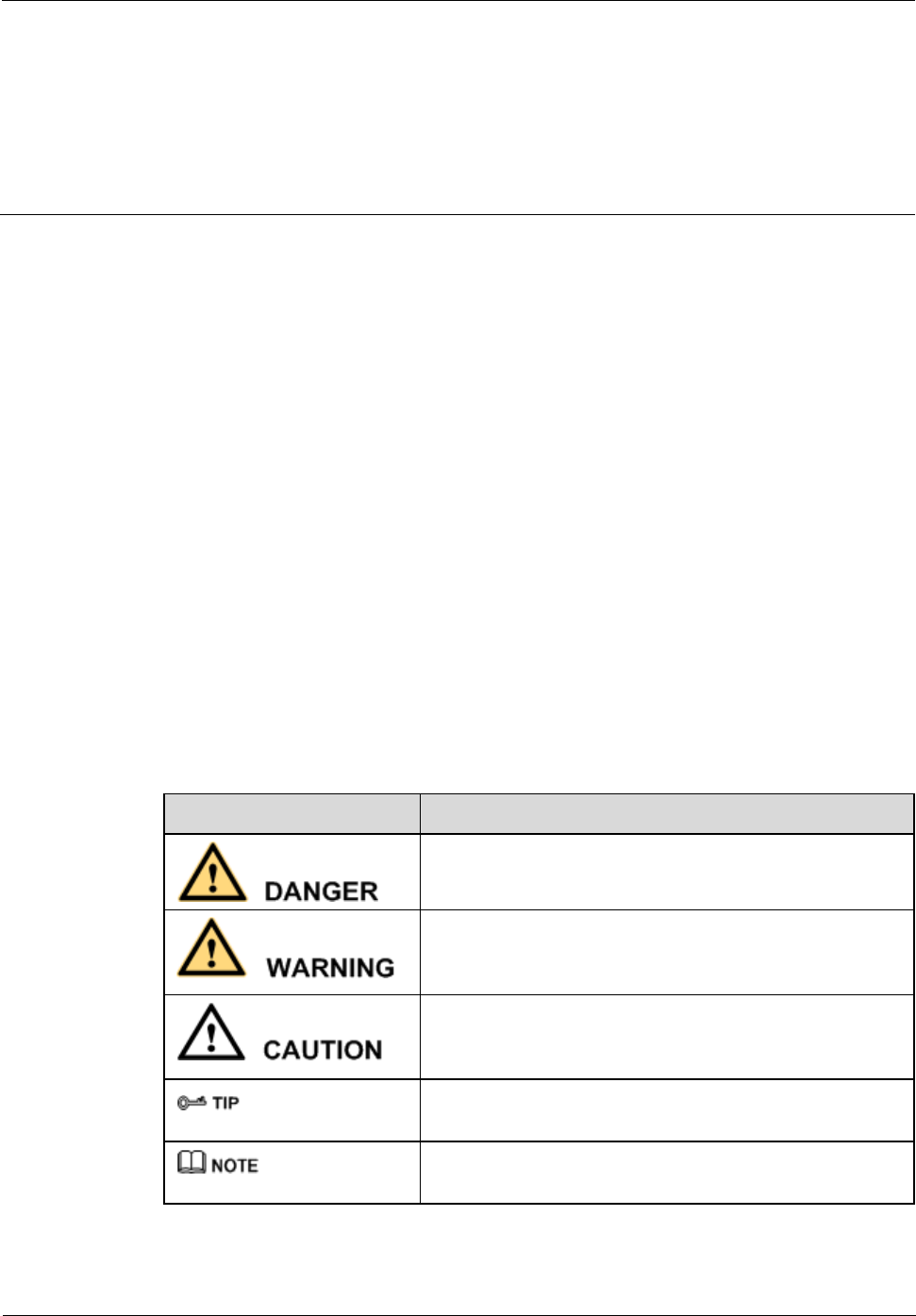
Huawei AR1200&AR2200&AR3200&AR3600 Series
Enterprise Routers
Safety and Regulatory Compliance Information
About This Document
Issue 07 (2015-05-08)
Huawei Proprietary and Confidential
Copyright © Huawei Technologies Co., Ltd.
ii
About This Document
Intended Audience
This document describes Electromagnetic Compatibility (EMC) and other safety standards
compliance and information about the AR1200&AR2200&AR3200&AR3600 series
enterprise routers.
This document provides the general safety guidelines for handling, installing or operating the
AR1200&AR2200&AR3200&AR3600 series enterprise routers.
This document is intended for:
Maintenance engineers
Technical support engineers
Installation engineers
Network planning engineers
Symbol Conventions
The symbols that may be found in this document are defined as follows.
Symbol
Description
Indicates a hazard with a high level of risk, which if not
avoided, will result in death or serious injury.
Indicates a hazard with a medium or low level of risk,
which if not avoided, could result in minor or moderate
injury.
Indicates a potentially hazardous situation, which if not
avoided, could result in equipment damage, data loss,
performance degradation, or unexpected results.
Indicates a tip that may help you solve a problem or save
time.
Provides additional information to emphasize or
supplement important points of the main text.

Huawei AR1200&AR2200&AR3200&AR3600 Series
Enterprise Routers
Safety and Regulatory Compliance Information
About This Document
Issue 07 (2015-05-08)
Huawei Proprietary and Confidential
Copyright © Huawei Technologies Co., Ltd.
iii
Change History
Changes between document issues are cumulative. Therefore, the latest document issue
contains all the changes in previous issues.
Changes in Issue 07 (2015-05-08)
The CE certificates of AR1200&AR2200&AR3200& AR3600 are updated.
Changes in Issue 06 (2013-12-25)
The CE certificates of AR1200&AR2200&AR3200 are updated.
Changes in Issue 05 (2012-12-31)
The CE certificates of AR1200&AR2200&AR3200 are updated.
Changes in Issue 04 (2012-06-30)
The following content is added:
Warning on the injuries that misoperation on fans may cause
FCC warning information
3G antenna warning information
The following content is modified:
Contact information on the title page
Changes in Issue 03 (2011-12-30)
The CE certificates of AR1200, AR2200, and AR3200 are updated.
Changes in Issue 02 (2011-10-15)
Two warning messages are added in the document for the wireless products.
Changes in Issue 01 (2011-06-25)
Initial commercial release.

Huawei AR1200&AR2200&AR3200&AR3600 Series
Enterprise Routers
Safety and Regulatory Compliance Information
Contents
Issue 07 (2015-05-08)
Huawei Proprietary and Confidential
Copyright © Huawei Technologies Co., Ltd.
iv
Contents
1 Regulatory Compliance Statement ............................................................................................ 1
1.1 European Community CE Certification ........................................................................................................... 2
2 Regulatory Compliance Information ........................................................................................ 4
2.1 Regulatory Compliance Standards ................................................................................................................... 4
2.2 European Directives Compliance ..................................................................................................................... 6
2.3 USA Regulatory Compliance ........................................................................................................................... 7
2.3.1 FCC Part 15 and 68 ................................................................................................................................. 7
2.4 Canada Regulatory Compliance ....................................................................................................................... 8
2.4.1 RSS-Gen & RSS-210 statement .............................................................................................................. 8
2.4.2 RSS-102 statement .................................................................................................................................. 8
2.5 Japanese Compliance ....................................................................................................................................... 8
2.5.1 VCCI ....................................................................................................................................................... 8
2.6 CISPR 22 Compliance ..................................................................................................................................... 8
3 Safety Information ...................................................................................................................... 10
3.1 Overview ........................................................................................................................................................ 10
3.1.1 Safety Precautions ................................................................................................................................. 10
3.1.2 General Requirements ........................................................................................................................... 11
3.2 Electricity Safety ............................................................................................................................................ 12
3.2.1 High Voltage ......................................................................................................................................... 12
3.2.2 Thunderstorm ........................................................................................................................................ 13
3.2.3 Tools ...................................................................................................................................................... 13
3.2.4 High Electrical Leakage ........................................................................................................................ 13
3.2.5 Power Cable .......................................................................................................................................... 14
3.2.6 Fuse ....................................................................................................................................................... 14
3.2.7 Electrostatic Discharge.......................................................................................................................... 14
3.3 Inflammable Environment .............................................................................................................................. 15
3.4 Battery ............................................................................................................................................................ 16
3.4.1 Storage Battery ...................................................................................................................................... 16
3.4.2 Lithium Battery ..................................................................................................................................... 18
3.5 Laser ............................................................................................................................................................... 18
3.5.1 General Laser Information .................................................................................................................... 18
3.5.2 Laser Safety Guidelines ........................................................................................................................ 19

Huawei AR1200&AR2200&AR3200&AR3600 Series
Enterprise Routers
Safety and Regulatory Compliance Information
Contents
Issue 07 (2015-05-08)
Huawei Proprietary and Confidential
Copyright © Huawei Technologies Co., Ltd.
v
3.5.3 Handling Fibers ..................................................................................................................................... 19
3.6 Working at Heights ......................................................................................................................................... 19
3.6.1 Weight Lifting ....................................................................................................................................... 20
3.6.2 Safety Guide on Ladder Use ................................................................................................................. 21
3.7 Mechanical Safety .......................................................................................................................................... 22
3.7.1 Drilling .................................................................................................................................................. 22
3.7.2 Sharp Objects ........................................................................................................................................ 22
3.7.3 Handling Fans ....................................................................................................................................... 22
3.7.4 Lifting Heavy Objects ........................................................................................................................... 23
3.8 Miscellaneous ................................................................................................................................................. 23
3.8.1 Inserting and Removing a Board ........................................................................................................... 23
3.8.2 Bundling Signal Cables ......................................................................................................................... 23
3.8.3 Cabling Requirements ........................................................................................................................... 24
3.9 3G Antenna..................................................................................................................................................... 24
4 Sicherheitsinformationen .......................................................................................................... 25
4.1 Überblick ........................................................................................................................................................ 26
4.1.1 Sicherheitsmaßnahmen ......................................................................................................................... 26
4.1.2 Allgemeine Anforderungen ................................................................................................................... 26
4.2 Elektrische Sicherheit ..................................................................................................................................... 28
4.2.1 Hochspannung ....................................................................................................................................... 28
4.2.2 Gewitter ................................................................................................................................................ 28
4.2.3 Werkzeuge ............................................................................................................................................. 29
4.2.4 Hoher Kriechstrom ................................................................................................................................ 29
4.2.5 Zuleitung ............................................................................................................................................... 29
4.2.6 Sicherung .............................................................................................................................................. 30
4.2.7 Elektrostatische Entladung .................................................................................................................... 30
4.3 Feuergefährliche Umgebung .......................................................................................................................... 31
4.4 Batterie ........................................................................................................................................................... 32
4.4.1 Speicherbatterie ..................................................................................................................................... 32
4.4.2 Lithium-Batterie .................................................................................................................................... 34
4.5 Laser ............................................................................................................................................................... 34
4.5.1 Allgemeine Informationen zum Laser ................................................................................................... 34
4.5.2 Sicherheitsrichtlinien für Laser ............................................................................................................. 35
4.5.3 Umgang mit Fasern ............................................................................................................................... 35
4.6 Arbeiten in großen Höhen .............................................................................................................................. 36
4.6.1 Heben von großen Gewichten ............................................................................................................... 36
4.6.2 Sicherheitsleitfaden zur Verwendung von Leitern ................................................................................ 37
4.7 Mechanische Sicherheit .................................................................................................................................. 38
4.7.1 Bohren ................................................................................................................................................... 38
4.7.2 Scharfkantige Gegenstände ................................................................................................................... 38
4.7.3 Umgang mit Ventilatoren ...................................................................................................................... 38

Huawei AR1200&AR2200&AR3200&AR3600 Series
Enterprise Routers
Safety and Regulatory Compliance Information
Contents
Issue 07 (2015-05-08)
Huawei Proprietary and Confidential
Copyright © Huawei Technologies Co., Ltd.
vi
4.7.4 Heben schwerer Gegenstände ............................................................................................................... 39
4.8 Verschiedenes ................................................................................................................................................. 39
4.8.1 Einsetzen und Entfernen von Leiterplatten ........................................................................................... 39
4.8.2 Bündeln von Signalleitungen ................................................................................................................ 40
4.8.3 Verkabelungsanforderungen .................................................................................................................. 40
4.9 3G Antenne..................................................................................................................................................... 40

Huawei AR1200&AR2200&AR3200&AR3600 Series
Enterprise Routers
Safety and Regulatory Compliance Information
1 Regulatory Compliance Statement
Issue 07 (2015-05-08)
Huawei Proprietary and Confidential
Copyright © Huawei Technologies Co., Ltd.
1
1 Regulatory Compliance Statement
About This Chapter
This chapter provides the certification details for AR1200&AR2200&AR3200&AR3600
Series Products.
European Community CE Certification Declaration of Conformity (DoC)
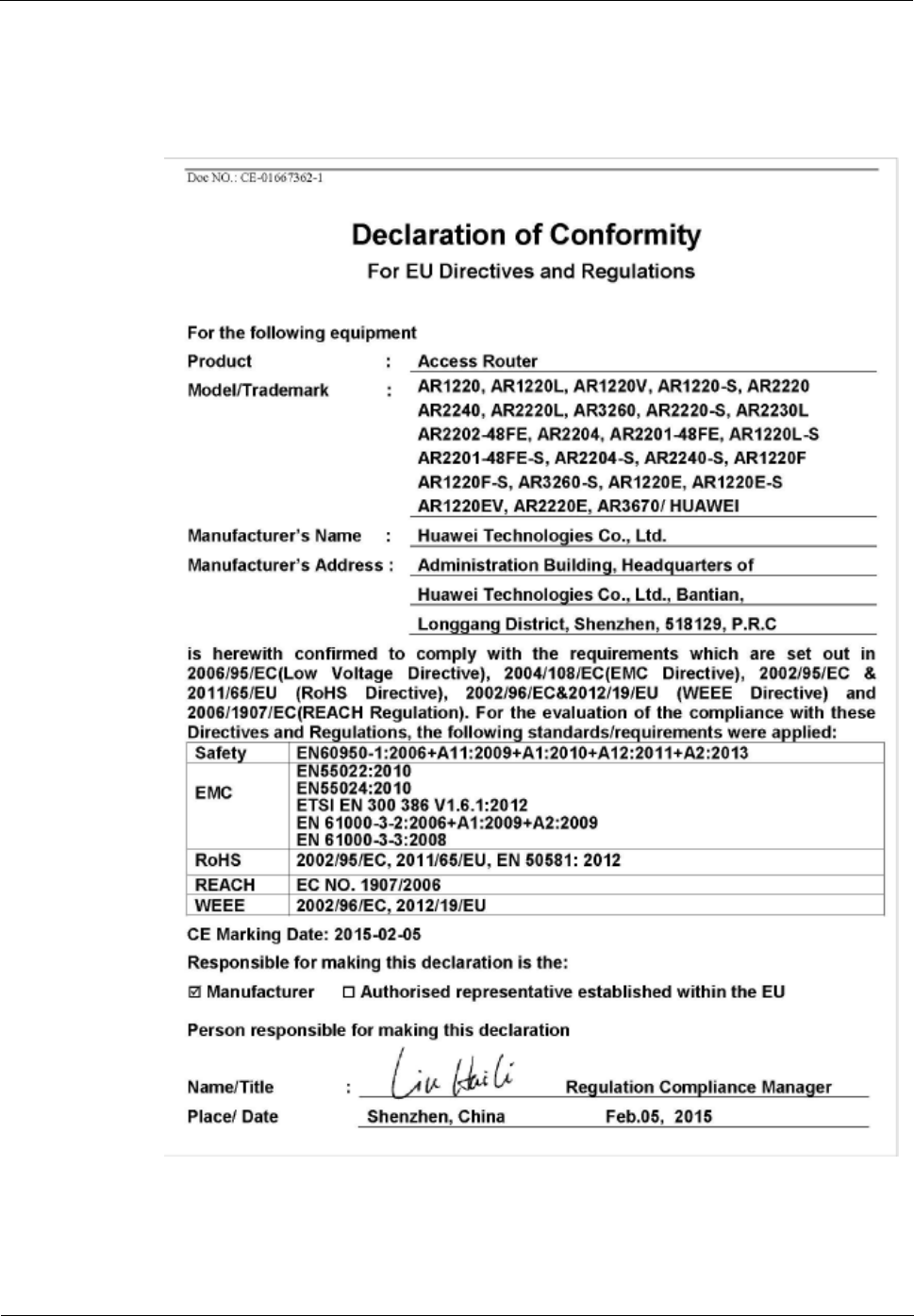
Huawei AR1200&AR2200&AR3200&AR3600 Series
Enterprise Routers
Safety and Regulatory Compliance Information
1 Regulatory Compliance Statement
Issue 07 (2015-05-08)
Huawei Proprietary and Confidential
Copyright © Huawei Technologies Co., Ltd.
2
1.1 European Community CE Certification
Figure 1-1 European community CE certification of AR1200&AR2200&AR3200&AR3600
Series Products.
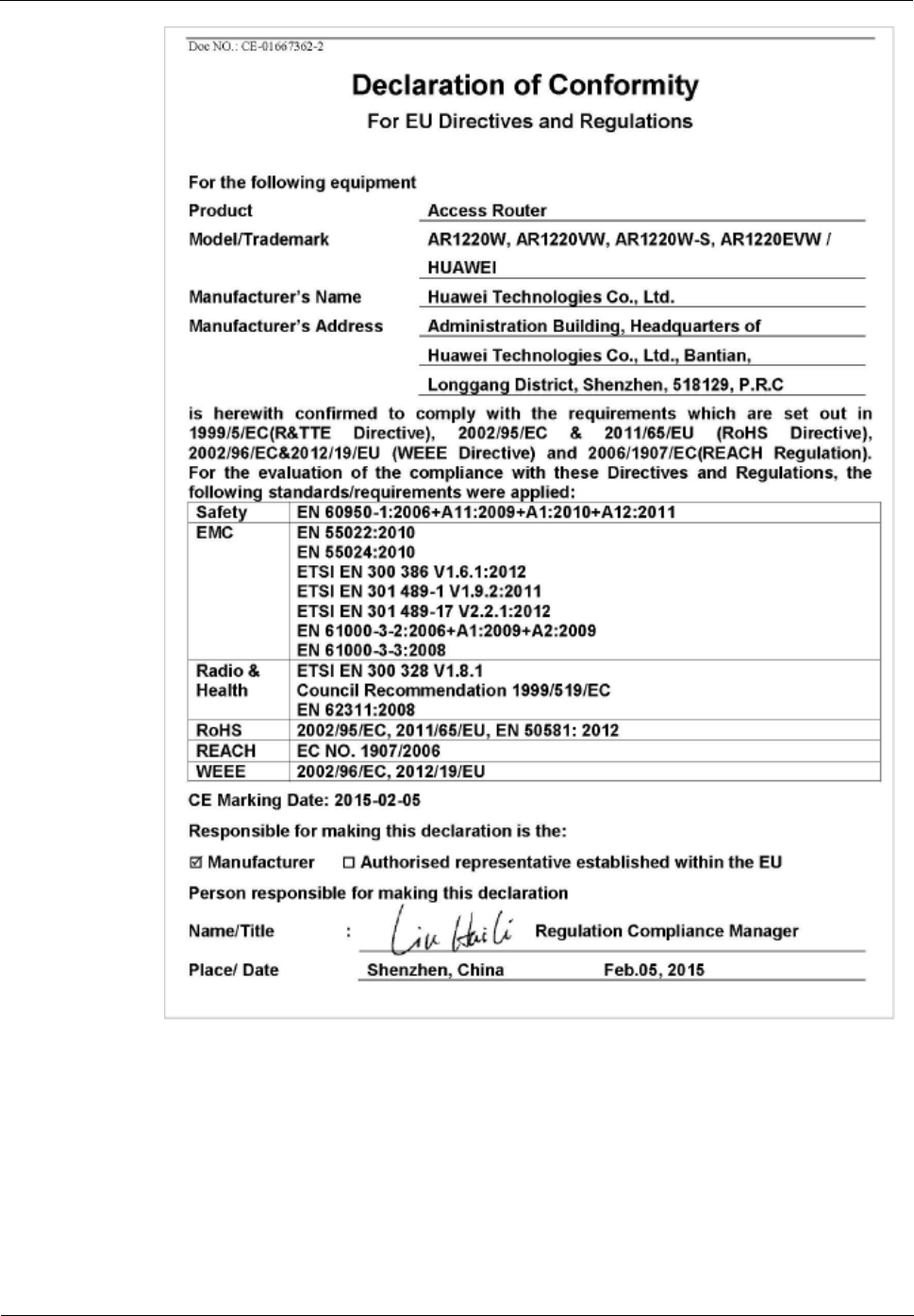
Huawei AR1200&AR2200&AR3200&AR3600 Series
Enterprise Routers
Safety and Regulatory Compliance Information
1 Regulatory Compliance Statement
Issue 07 (2015-05-08)
Huawei Proprietary and Confidential
Copyright © Huawei Technologies Co., Ltd.
3

Huawei AR1200&AR2200&AR3200&AR3600 Series
Enterprise Routers
Safety and Regulatory Compliance Information
2 Regulatory Compliance Information
Issue 07 (2015-05-08)
Huawei Proprietary and Confidential
Copyright © Huawei Technologies Co., Ltd.
4
2 Regulatory Compliance Information
About This Chapter
The following table lists the contents of this chapter.
Title
Description
2.1 Regulatory Compliance
Standards
The regulatory compliance standards on EMC, safety,
NEBS, telecom, Laser Radiation, RF, health, and
environmental protection.
2.2 European Directives
Compliance
The compliance with European directives, including
RoHS compliance and device recycling guide.
2.3 USA Regulatory
Compliance
The USA regulatory compliance, including FCC part 15.
2.5 Japanese Compliance
The Japan regulatory compliance, including VCCI Class
A.
2.6 CISPR 22 Compliance
The CISPR 22 regulatory compliance.
2.1 Regulatory Compliance Standards
AR1200&AR2200&AR3200&AR3600 Series Products comply with the standards listed in
Table 2-1.

Huawei AR1200&AR2200&AR3200&AR3600 Series
Enterprise Routers
Safety and Regulatory Compliance Information
2 Regulatory Compliance Information
Issue 07 (2015-05-08)
Huawei Proprietary and Confidential
Copyright © Huawei Technologies Co., Ltd.
5
Table 2-1 Regulatory compliance standards
Discipline
Standards
EMC
CISPR22 Class A
CISPR24
EN55022 Class A
EN50024
ETSI EN 300 386 Class A
CFR 47 FCC Part 15 Class A
ICES 003 Class A
AS/NZS CISPR22 Class A
GB9254 Class A
VCCI Class A
CNS 13438 Class A
IEC61000-3-2
IEC61000-3-3
EN61000-3-2
EN61000-3-3
ITU-T K.20
ITU-T K.44
ITU-T K.45
Safety
IEC 60950-1
IEC/EN41003
EN 60950-1
UL 60950-1
CSA C22.2 No 60950-1
AS/NZS 60950.1
BS EN 60950-1
IS 13252
GB4943
Laser safety
FDA rules, 21 CFR 1040.10 and 1040.11
IEC60825-1, IEC60825-2, EN60825-1, EN60825-2
GB7247
Health
ICNIRP Guideline
1999-519-EC
EN 50385
OET Bulletin 65
IEEE Std C95.1
EN 60215
Environmental protection
RoHS

Huawei AR1200&AR2200&AR3200&AR3600 Series
Enterprise Routers
Safety and Regulatory Compliance Information
2 Regulatory Compliance Information
Issue 07 (2015-05-08)
Huawei Proprietary and Confidential
Copyright © Huawei Technologies Co., Ltd.
6
Discipline
Standards
Grounding
ITU-T K.27
ETSI EN 300 253
Note:
EMC: electromagnetic compatibility
NEBS: Network Equipment Build Standard
RF: radio frequency
CISPR: International Special Committee on Radio Interference
EN: European Standard
ETSI: European Telecommunications Standards Institute
CFR: Code of Federal Regulations
FCC: Federal Communication Commission
IEC: International Electrotechnical Commission
AS/NZS: Australian/New Zealand Standard
VCCI: Voluntary Control Council for Interference
CNS: Chinese National Standard
UL: Underwriters Laboratories
CSA: Canadian Standards Association
BS: British Standard
IS: Indian Standard
GR: general requirement
FDA: Food and Drug Administration
BTS: base transceiver station
GSM: Global System for Mobile communications
WLAN: wireless local area network
ICNIRP: International Commission on Non-Ionizing Radiation Protection
OET: Office of Engineering Technology
IEEE: Institute of Electrical and Electronics Engineers
RoHS: restriction of the use of certain hazardous substances
2.2 European Directives Compliance
AR1200&AR2200&AR3200&AR3600 Series Products comply with the following European
directives.
89/336/EC (EMC)
2006/95/EC (low voltage)
1999/5/EC (R&TTE)
Refer to Figure 1-1 for Huawei Declaration of Conformity.

Huawei AR1200&AR2200&AR3200&AR3600 Series
Enterprise Routers
Safety and Regulatory Compliance Information
2 Regulatory Compliance Information
Issue 07 (2015-05-08)
Huawei Proprietary and Confidential
Copyright © Huawei Technologies Co., Ltd.
7
AR1200&AR2200&AR3200&AR3600 Series Products comply with Directive 2002/95/EC,
on the RoHS in electrical and electronic equipment. The device does not contain lead,
mercury, cadmium, and hexavalent chromium and brominated flame retardants
(polybrominated biphenyls (PBB) or polybrominated diphenyl ethers (PBDE)) except for
those exempted applications allowed by RoHS directive for technical reasons.
AR1200&AR2200&AR3200&AR3600 Series Products comply with Directive 2002/96/EC
on waste electrical and electronic equipment. Huawei is responsible for recycling its
end-of-life devices. Contact Huawei local service center when recycling is required.
The main materials in the device are steel, plastics, copper, and electronic components. Most
of the materials are recyclable.
Comply with the following rules for recycling at the end of life of the device.
Remove power first in the disassembly.
Remove and send battery、PCB、fans and cables to special institution for disposal
because it contains chemical substance.
Dispose of battery separately because it contains hazardous substance.
No hazardous substance is contained in the label printing ink and plastic paint, and no
hazardous gas is emitted when the label printing ink and plastic paint is burning.
Dispose of the yellow chromate conversion coating screw separately because it contains
Cr6+.
Provide the plastic marking reference, such as ISO1043, and EN50419.
2.3 USA Regulatory Compliance
2.3.1 FCC Part 15 and 68
AR1200&AR2200&AR3200&AR3600 Series Products comply with Part 15 and 68 of the
FCC Rules. Operation is subject to the following two conditions:
This device does not cause harmful interference.
This device must accept any interference received, including interference that may cause
undesired operation.
This device has been tested and found to comply with the limits for a Class A digital
device, pursuant to Part 15 of the FCC Rules. These limits are designed to provide
reasonable protection against harmful interference when the device is operated in a
commercial environment.
This equipment complies with FCC RF radiation exposure limits set forth for an
uncontrolled environment. This transmitter must not be co-located or operating in
conjunction with any other antenna or transmitter. This equipment should be installed
and operated with a minimum distance of 20 centimeters between the radiator and your
body.
WARNING

Huawei AR1200&AR2200&AR3200&AR3600 Series
Enterprise Routers
Safety and Regulatory Compliance Information
2 Regulatory Compliance Information
Issue 07 (2015-05-08)
Huawei Proprietary and Confidential
Copyright © Huawei Technologies Co., Ltd.
8
If this device is modified without authorization from Huawei, the device may no longer
comply with FCC requirements for Class A digital devices. In that a case, your right to use the
device may be limited by FCC regulations. Moreover, you may be required to correct any
interference to radio or television communications at your own expense.
This device has been tested and found to comply with the limits for a Class A digital device,
pursuant to Part 15 of the FCC Rules. These limits are designed to provide reasonable
protection against harmful interference when the device is operated in a commercial
environment.
This device generates, uses and radiates radio frequency energy. If it is not installed and used
in accordance with the instructions, it may cause harmful interference to radio
communications.
Operation of this device in a residential area is likely to cause harmful interference. In this
case the user will be requested to correct the interference at his or her own expense.
2.4 Canada Regulatory Compliance
2.4.1 RSS-Gen & RSS-210 statement
This device complies with Industry Canada licence-exempt RSS standard(s).
Operation is subject to the following two conditions: (1) this device may not cause
interference, and (2) this device must accept any interference, including interference that
may cause undesired operation of the device.
2.4.2 RSS-102 statement
This equipment complies with IC radiation exposure limits set forth for an uncontrolled
environment. This equipment should be installed and operated with minimum distance 20 cm
between the radiator and your body.
2.5 Japanese Compliance
2.5.1 VCCI
AR1200&AR2200&AR3200&AR3600 Series Products comply with VCCI Class A by
Information Technology Equipment (ITE).
2.6 CISPR 22 Compliance
AR1200&AR2200&AR3200&AR3600 Series Products comply with CISPR 22 for Class A
by the ITE.

Huawei AR1200&AR2200&AR3200&AR3600 Series
Enterprise Routers
Safety and Regulatory Compliance Information
2 Regulatory Compliance Information
Issue 07 (2015-05-08)
Huawei Proprietary and Confidential
Copyright © Huawei Technologies Co., Ltd.
9
Class A ITE is a category of all other ITE that satisfies only the Class A ITE regulations, and
not the Class B ITE regulations. Such equipment should not be restricted in its sale but the
following warning shall be included in the instructions for use:
This is Class A Product. In a domestic environment this product may cause radio interference;
therefore, the user is required to take appropriate measures.
WARNING

Huawei AR1200&AR2200&AR3200&AR3600 Series
Enterprise Routers
Safety and Regulatory Compliance Information
3 Safety Information
Issue 07 (2015-05-08)
Huawei Proprietary and Confidential
Copyright © Huawei Technologies Co., Ltd.
10
3 Safety Information
About This Chapter
The following table lists the contents of this chapter.
Title
Description
3.1 Overview
Safety precautions to be taken before installing and
maintaining the Huawei device.
3.2 Electricity Safety
Information about the electricity safety.
3.3 Inflammable Environment
Information about the inflammable environment safety.
3.4 Battery
Information about the battery safety.
3.5 Laser
Safety precautions on the Electromagnetic Field Exposure
of the device and laser.
3.6 Working at Heights
Safety precautions to be taken before using the ladders or
hoisting heavy objects.
3.7 Mechanical Safety
Safety precautions on drilling, on sharp objects, on
handling fans, and on lifting heavy objects.
3.8 Miscellaneous
Safety precautions on inserting and removing boards, on
bundling signal cables, and cabling requirements.
3.1 Overview
3.1.1 Safety Precautions
This section describes the safety precautions to be taken before installing and maintaining the
Huawei device.

Huawei AR1200&AR2200&AR3200&AR3600 Series
Enterprise Routers
Safety and Regulatory Compliance Information
3 Safety Information
Issue 07 (2015-05-08)
Huawei Proprietary and Confidential
Copyright © Huawei Technologies Co., Ltd.
11
Before performing an operation, read the operation instructions and precautions to be
taken, and follow them to prevent accidents. The Caution, Warning and Danger items in
other documents do not cover all the safety precautions that must be followed. They are
only supplementary information. The installation and maintenance personnel need to
understand the basic safety precautions to be taken.
When operating the device, obey the local safety regulations. The safety precautions
provided in the documents are supplementary and shall be in compliance with the local
safety regulations.
When operating the Huawei device, in addition to the precautions, follow the specific
safety instructions given by Huawei.
The installation and maintenance personnel must receive training in safety precautions.
Only qualified personnel can install or maintain the device.
3.1.2 General Requirements
To minimize the technically residual risk, it is imperative to obey the following rules. Read all
the instructions before operation.
Installation
The device (or system) must be installed or used in the access restricted location.
Be care the hot surface when the device is operating. When touching the surface or
operating the handle of the device by hands, wear gloves to protect your hands from
scalding.
Before operation, the device must be fixed securely on the floor or to other reliable
objects, such as the walls and the mounting racks.
When installing the unit, always make the ground connection first and disconnect it at
the end.
Do not block the ventilation while the device is running. Keep a minimum distance of 5
cm from the ventilation to the walls or the other objects that block the ventilation.
Tighten the thumbscrews by using a tool after both initial installation and subsequent
access to the panel.
Ground
Do not damage the ground conductor or operate the device in the absence of well
installed ground conductor. Conduct the appropriate electrical inspection.
The device (or system) must be connected permanently to the protection ground before
an operation. The cross sectional area of protective ground conductor shall be at least 1.0
mm².
Power Supply
For AC supplied model: The socket-outlet shall be installed near the equipment and shall
be easily accessible.
For AC supplied model: The device applies to TN, TT power systems.
For DC supplied model: Reinforced insulation or double insulation must be provided to
isolate DC source from the AC mains supply".
For DC supplied model: A readily accessible disconnect device shall be incorporated in
the building installation wiring".

Huawei AR1200&AR2200&AR3200&AR3600 Series
Enterprise Routers
Safety and Regulatory Compliance Information
3 Safety Information
Issue 07 (2015-05-08)
Huawei Proprietary and Confidential
Copyright © Huawei Technologies Co., Ltd.
12
Prepared conductors are connected to the terminal block, and only appropriate
AWG/Type of wire is secured in the listed lug terminals.
This device relies on the building’s installation for short-circuit (overcurrent) protection.
Ensure that a fuse or circuit breaker no larger than 240 VAC, 20 A for AC supplied model
or 80 VDC, 10 A for DC supplied model is used on the phase conductors (all
current-carrying conductors).
For AC supplied model: The plug-socket combination must be accessible at all times
because it serves as the main disconnect device.
Because the device has several power supplies, disconnect all of them to switch off the
device.
The AC power supply has double pole/neutral fusing.
To reduce the risk of fire, use only No. 26 AWG or larger telecommunication line cord.
Human Safety
Do not operate the device or cables at lightning strikes.
To avoid electric shock, do not connect safety extra-low voltage (SELV) circuits to
telecommunication network voltage (TNV) circuits.
Do not look directly into the optical port to prevent the laser radiation from injuring your
eyes.
Do not wear jewelry or watches when you operate the device.
Operator
Only qualified and skilled personnel must install, configure, and disassemble the device.
Only the personnel authorized must operate the device.
Any replacement or change to the device or parts of the device (including the software)
must be done by qualified or authorized personnel of Huawei.
Any fault or error that might cause safety problems must be reported immediately to the
person in charge.
Only qualified personnel must remove or disable the safety facilities, or to troubleshoot
and maintain the device.
Ensure that the instructions provided in this document are followed completely. The document
also provides guidelines in selecting the measuring and testing device.
3.2 Electricity Safety
3.2.1 High Voltage
The high voltage power supply offers power for the device operation. Direct or indirect
contact (through damp objects) with high voltage and AC mains supply may result in fatal
danger.
DANGER
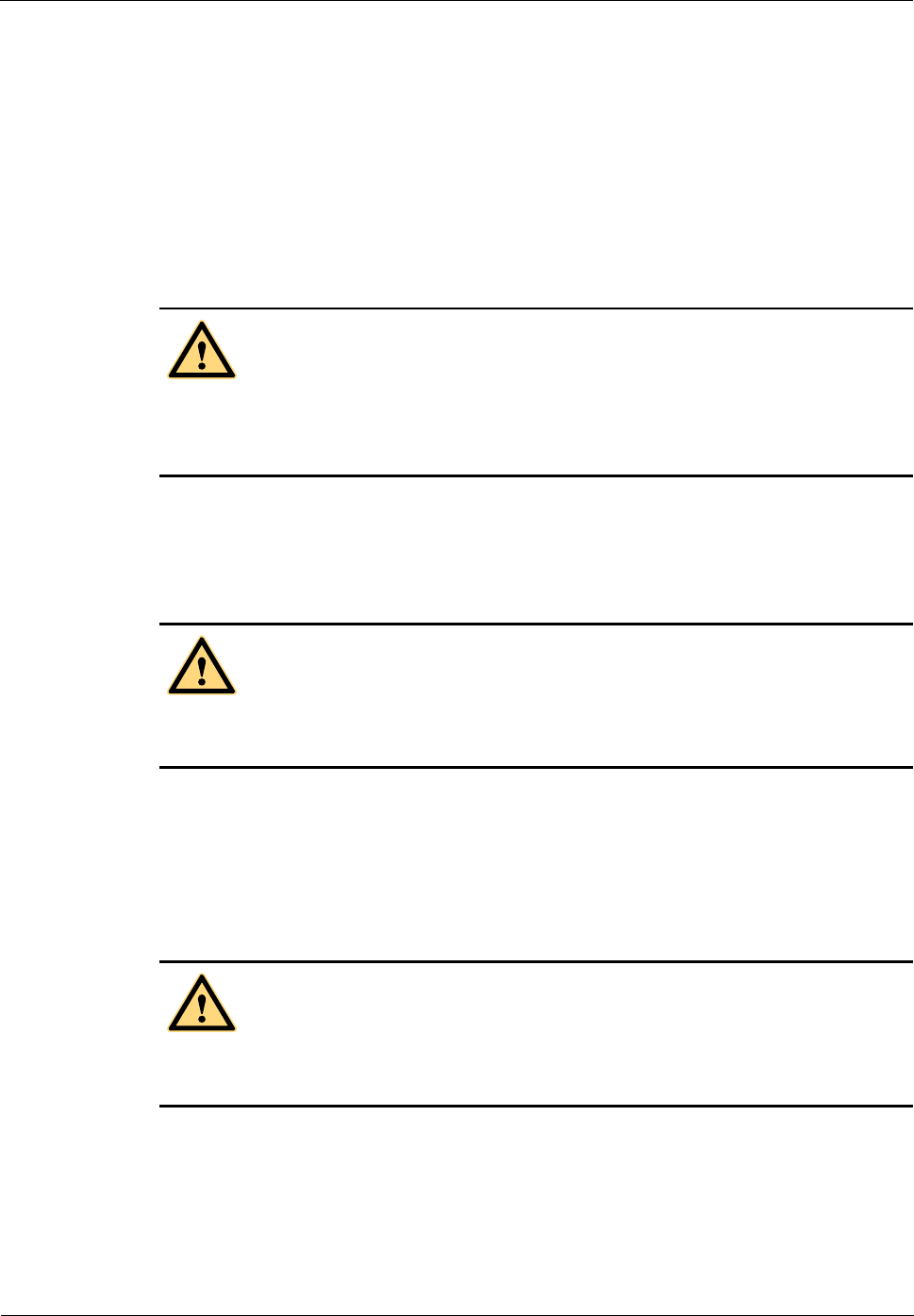
Huawei AR1200&AR2200&AR3200&AR3600 Series
Enterprise Routers
Safety and Regulatory Compliance Information
3 Safety Information
Issue 07 (2015-05-08)
Huawei Proprietary and Confidential
Copyright © Huawei Technologies Co., Ltd.
13
During the installation of the AC power supply facility, follow the local safety
regulations. The personnel who install the AC facility must be qualified to perform high
voltage and AC operations.
Do not wear conductive articles, such as watches, hand chains, bracelets and rings during
the operation.
When water is found in the rack or the rack is damp, switch off the power supply
immediately.
When the operation is performed in a damp environment, make sure that the device is
dry.
Non-standard and improper high voltage operations may result in fire and electric shock.
Therefore, you must obey the local rules and regulations when bridging and wiring AC cables.
Only qualified personnel must perform high voltage and AC operations.
3.2.2 Thunderstorm
High voltage and AC operations, or operations on a steel tower and a mast are prohibited
during thunderstorm.
During thunderstorm, the electromagnetic field generated in the thunderstorm area may
damage the electronic parts. To prevent damage to the device during lightning, ground the
device properly.
3.2.3 Tools
Suggestion: Dedicated tools must be used during high voltage and AC operations. Avoid using
ordinary tools.
3.2.4 High Electrical Leakage
WARNING
DANGER
WARNING
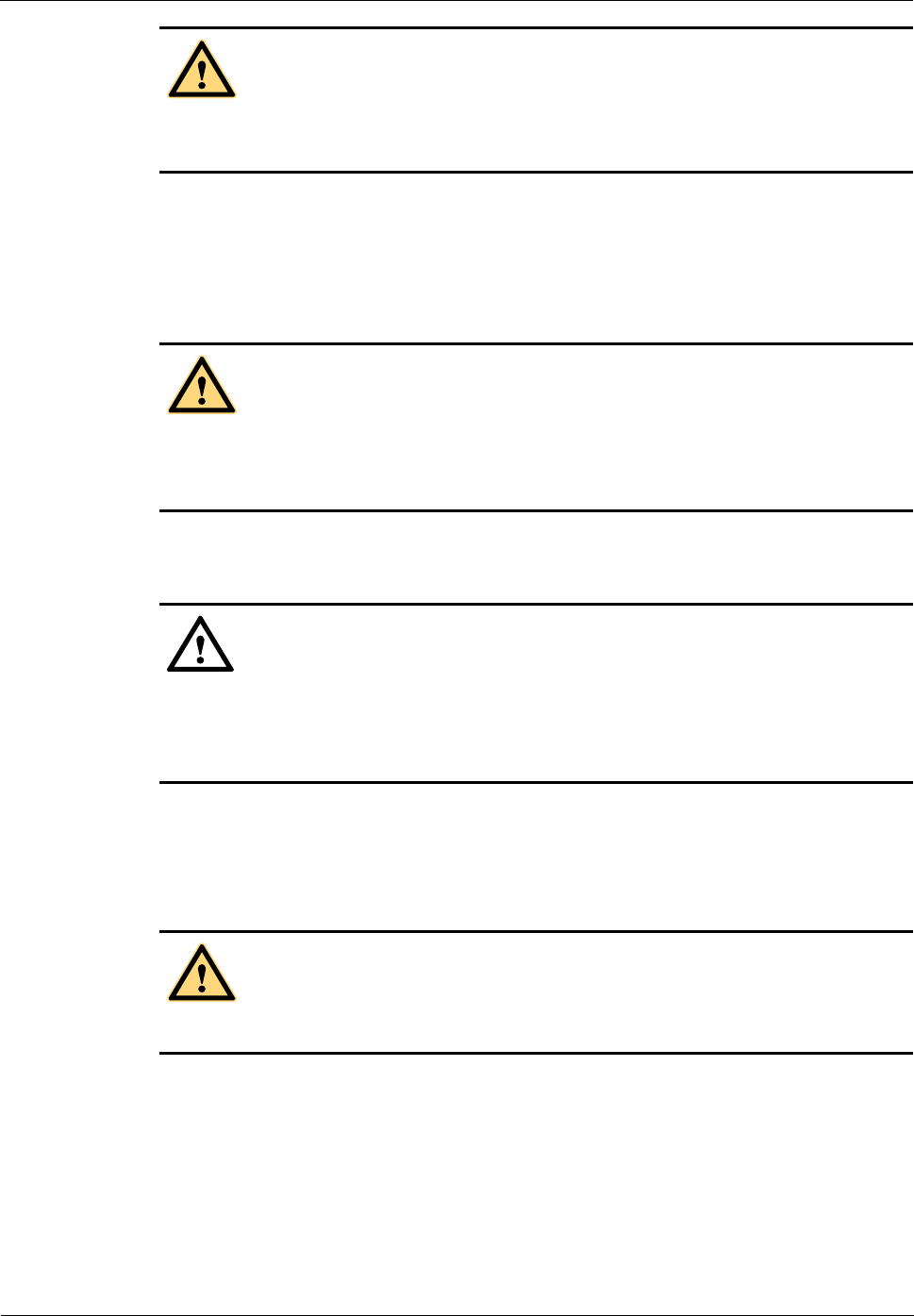
Huawei AR1200&AR2200&AR3200&AR3600 Series
Enterprise Routers
Safety and Regulatory Compliance Information
3 Safety Information
Issue 07 (2015-05-08)
Huawei Proprietary and Confidential
Copyright © Huawei Technologies Co., Ltd.
14
Ground the device before powering on the device. Otherwise, the personnel and device are in
danger.
If the "high electrical leakage" flag is stuck to the power terminal of the device, you must
ground the device before powering it on.
3.2.5 Power Cable
Installation and removal of live line are prohibited. Transient contact between the core of the
power cable and the conductor may generate electric arc or spark, which may cause fire or eye
injury.
Before installing or removing the power cable, turn off the power switch.
Before connecting the power cable, confirm that the power cable and label comply with
the requirements of the actual installation.
For the DC power supplied device, use 1.0 mm² or 16 AWG minimum power supply cord.
For AC power supplied device, use 1.0 mm² or 16 AWG minimum power supply cord.
Use the type H03VV-F or light PVC sheathed flexible cord based on IEC 60227.
3.2.6 Fuse
If a fuse is to be replaced, the new fuse shall be of the same type and specifications.
3.2.7 Electrostatic Discharge
WARNING
WARNING
CAUTION
WARNING
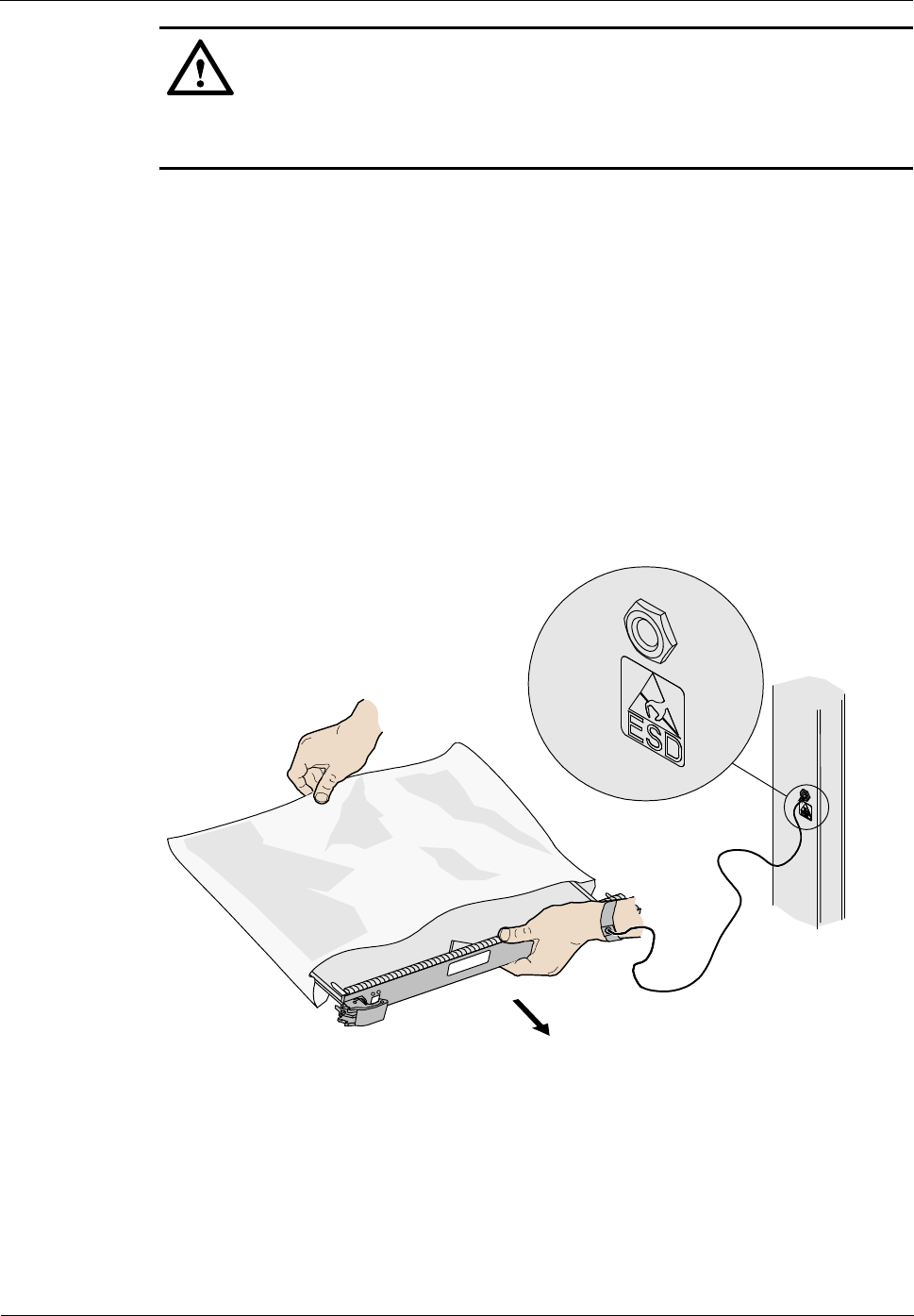
Huawei AR1200&AR2200&AR3200&AR3600 Series
Enterprise Routers
Safety and Regulatory Compliance Information
3 Safety Information
Issue 07 (2015-05-08)
Huawei Proprietary and Confidential
Copyright © Huawei Technologies Co., Ltd.
15
The static electricity generated by the human body may damage the electrostatic sensitive
components on the circuit board, such as the large-scale integrated circuit (LSI).
In the following situations, the human body will generate a static electromagnetic field:
Human body moving
Clothes friction
Friction between shoes and the ground
Holding ordinary plastic in hand
The static electromagnetic field will remain within the human body for a long time.
Before touching the device, hand-operating parts, circuit boards, or ASICs, wear a grounded
electrostatic discharge (ESD) wrist strap. It can prevent the sensitive components from
damage by the static electricity in the human body.
Figure 3-1 shows the wearing of an ESD wrist strap.
Figure 3-1 Wearing an ESD wrist strap
3.3 Inflammable Environment
Operating the electrical device in inflammable environment can be fatal.
CAUTION
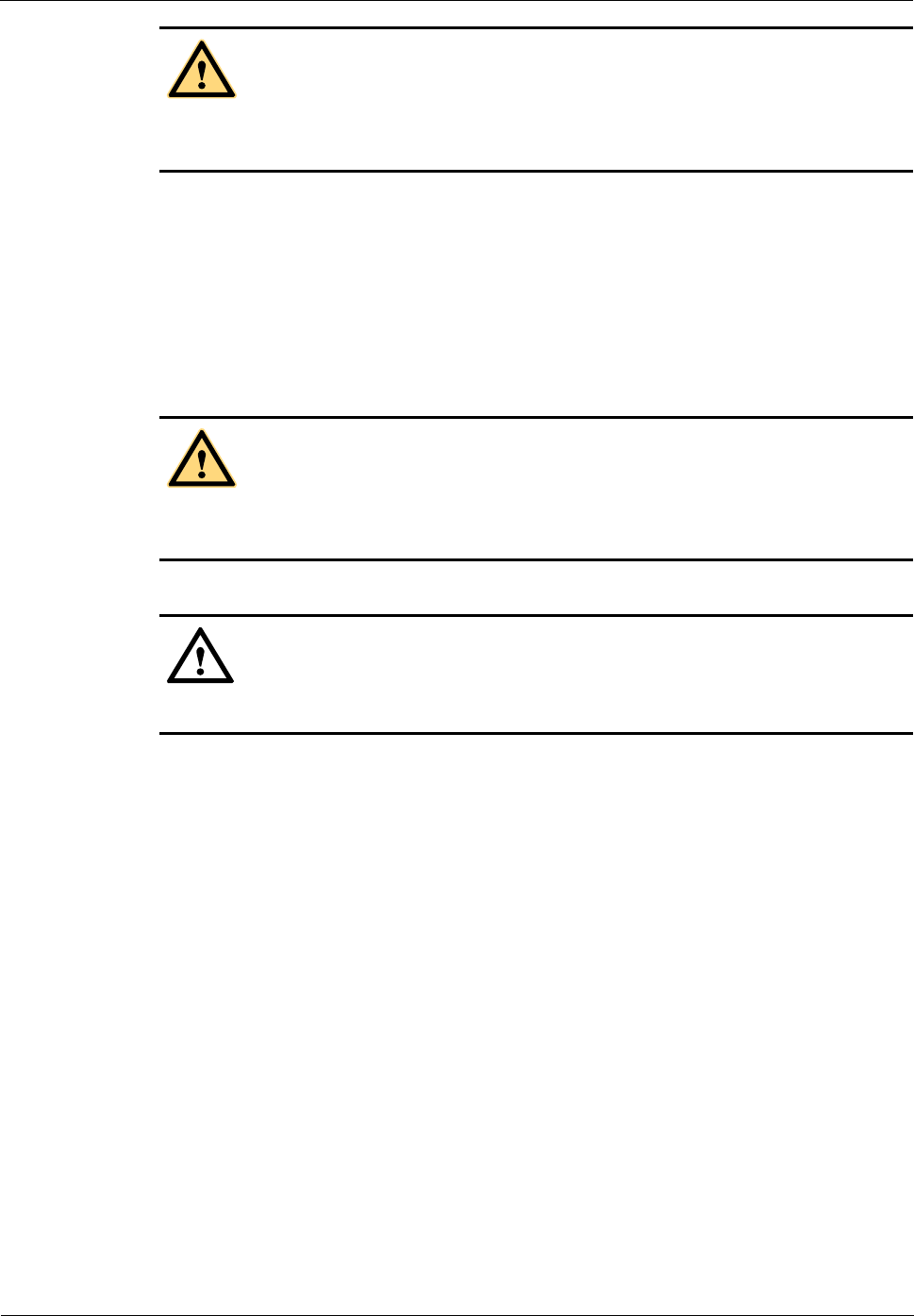
Huawei AR1200&AR2200&AR3200&AR3600 Series
Enterprise Routers
Safety and Regulatory Compliance Information
3 Safety Information
Issue 07 (2015-05-08)
Huawei Proprietary and Confidential
Copyright © Huawei Technologies Co., Ltd.
16
Do not place the device in the environment that has inflammable and explosive air or fog. Do
not perform any operation in this environment.
3.4 Battery
3.4.1 Storage Battery
Before handling the battery, read carefully the safety precautions to be taken for battery
handling and connections.
Non-standard operation on batteries may result in danger.
During operation:
Protect the battery against short-circuit
Prevent electrolyte overflow and leakage
Electrolyte overflow may damage the device. It will corrode the metal parts and the circuit
boards, and ultimately damage the device and cause short-circuit of the circuit boards.
General Operations
Before installing and maintaining the battery, note the following:
Do not wear metal articles such as wristwatch, hand chain, bracelet and ring.
Use special-purpose insulation tools.
Take care to protect you eyes when operating the device.
Wear rubber gloves and an apron in the case of electrolyte overflow.
Always keep the electrode front upright when handling the battery. Do not place the
battery upside down or tilt it.
Short-Circuit
DANGER
DANGER
CAUTION
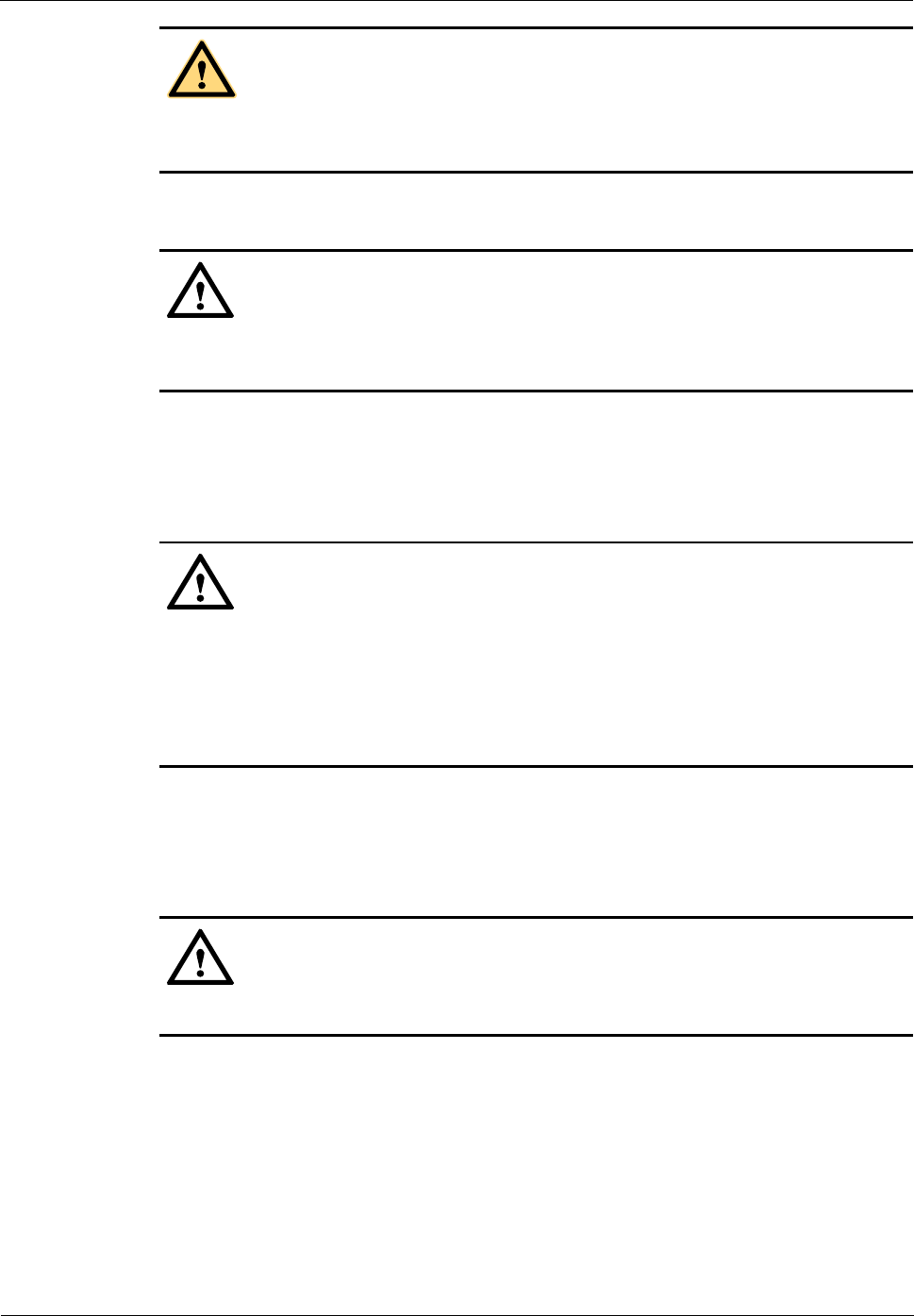
Huawei AR1200&AR2200&AR3200&AR3600 Series
Enterprise Routers
Safety and Regulatory Compliance Information
3 Safety Information
Issue 07 (2015-05-08)
Huawei Proprietary and Confidential
Copyright © Huawei Technologies Co., Ltd.
17
Battery short-circuit may cause physical injury. Though voltage of a general battery is low,
high transient current generated by short-circuit will release a large amount of power.
There is danger of explosion if the battery is incorrectly replaced. Therefore, replace the
battery only with the same or equivalent type recommended by the manufacturer.
Keep away metal objects, which may cause battery short-circuit, from batteries. If they have
to be used, first disconnect the batteries in use before performing any other operations.
Harmful Gas
Do not use unsealed lead-acid batteries, because the gas emitted from the battery may
result in fire or device corrosion.
Lay the battery horizontally and fix it properly.
The battery in use will emit flammable gas. Therefore, put the battery in a place with good
ventilation, and take fire precautions.
High Temperature
High temperature may result in distortion, damage and electrolyte overflow of the battery.
When the temperature of the battery exceeds 60C, check whether there is acid liquid
overflow. If acid liquid overflow occurs, handle the acid liquid immediately.
Acid Liquid
WARNING
CAUTION
CAUTION
CAUTION
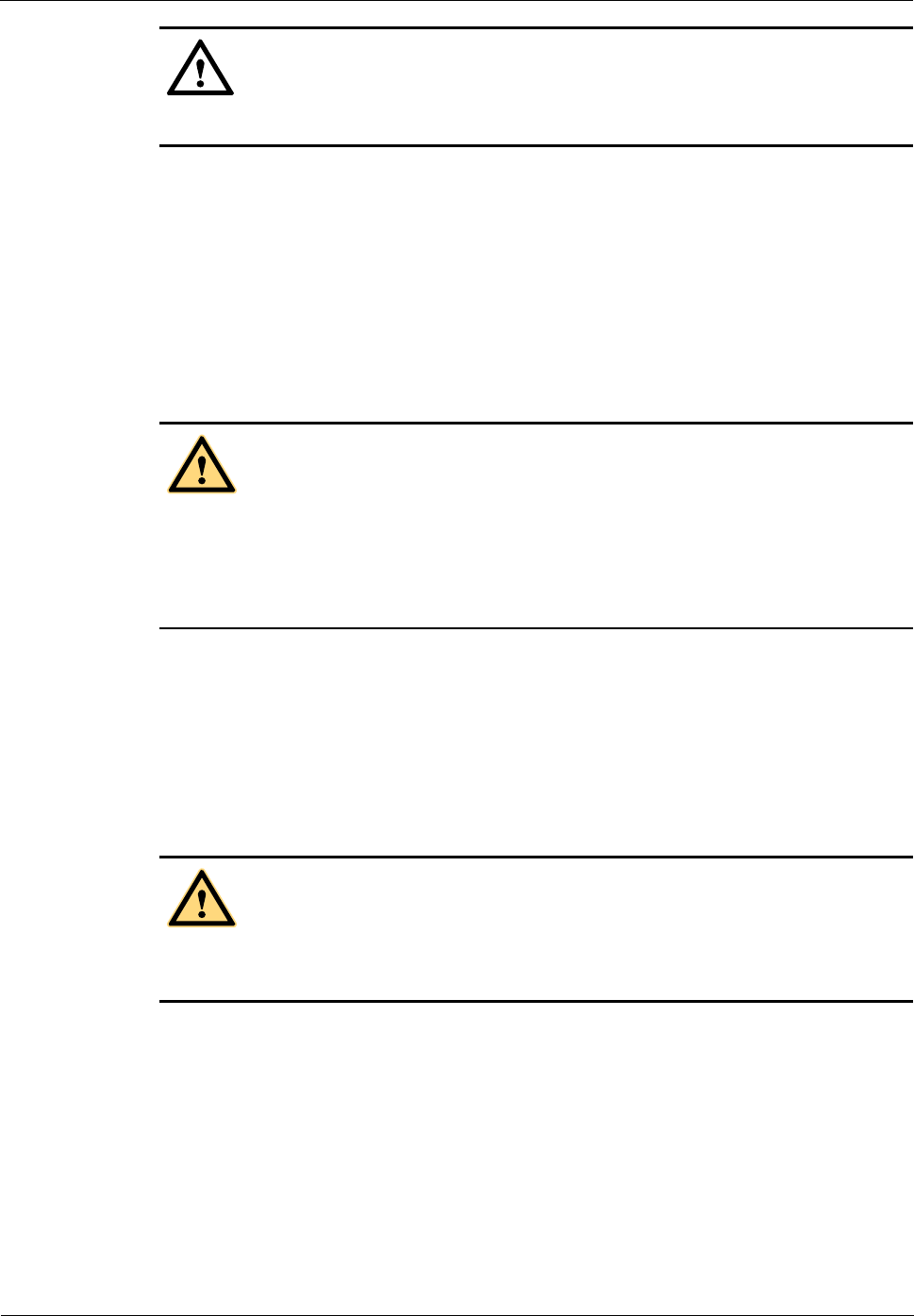
Huawei AR1200&AR2200&AR3200&AR3600 Series
Enterprise Routers
Safety and Regulatory Compliance Information
3 Safety Information
Issue 07 (2015-05-08)
Huawei Proprietary and Confidential
Copyright © Huawei Technologies Co., Ltd.
18
In case of acid liquid overflow, absorb and neutralize the liquid immediately.
When moving or removing a leaky battery, note the possible damage caused by the acid liquid.
Once the acid liquid spill is found, use the following materials to absorb and neutralize it.
Sodium bicarbonate (baking soda): NaHCO3
Sodium carbonate (soda): Na2CO3
The use of antacids must follow the guide provided by the battery supplier.
3.4.2 Lithium Battery
There is danger of explosion if the battery is incorrectly replaced. Therefore, replace the
battery only with the same or equivalent type recommended by the manufacturer.
Dispose the used batteries according to the manufacturer's instructions.
Do not dispose of lithium battery in fire.
3.5 Laser
The laser hazard level of this device is Class 1.
When handling optical fibers, do not stand close to, or look at the optical fiber outlet directly
with unaided eyes.
3.5.1 General Laser Information
Laser transceivers or transmitters are used in the optical transmission system and associated
test tools. The wavelength of the laser is between 780 nm and 1600 nm. Because the laser is
transmitted through the optical fiber, it has very high power density and is invisible to human
eyes. When a beam of light enters the eye, the retina may be damaged.
Laser of wavelengths used in telecommunications can cause thermal damage to the retina.
CAUTION
WARNING
WARNING

Huawei AR1200&AR2200&AR3200&AR3600 Series
Enterprise Routers
Safety and Regulatory Compliance Information
3 Safety Information
Issue 07 (2015-05-08)
Huawei Proprietary and Confidential
Copyright © Huawei Technologies Co., Ltd.
19
Lasers used in lightwave systems have a larger beam divergence, typically 10 to 20 degrees.
Viewing an un-terminated fiber or damaged fiber with the unaided eye at distances greater
than 150 mm (6 inches) will normally not cause eye injury. However, damage may occur if an
optical tool such as a microscope, magnifying glass or eye loupe is used to view the energized
fiber end.
In its normal operating mode, a lightwave system is totally enclosed and presents no risk of
eye injury. Additional safety is achieved by an automatic laser shut-down (ALS) of the system.
The ALS, however, can be applied for bi-directional transmission only. If the receiver side
does not detect the laser from the transmission side, it will give the transmission side a signal.
Upon receiving the signal, the ALS will shut down the laser emission within 100 ms.
3.5.2 Laser Safety Guidelines
Read the following guidelines to avoid laser radiation:
Read the instructions before installing, operating and maintaining the device. Ignoring
the instructions can cause exposure to dangerous laser radiation.
Wear a pair of eye-protective glasses when you are handling lasers or fibers.
All the operation shall be performed by personnel who have completed the approved
training courses.
Make sure that the optical source is switched off before disconnecting optical fiber
connectors.
Before opening the front door of an optical transmission system, make sure that you are
not exposed to laser radiation.
Do not look at the end of an exposed fiber or an open connector when you are not sure
whether the optical source is switched off or not.
Use an optical power meter to check and ensure that the optical source is switched off by
measuring the optical power.
Do not use an optical tool such as a microscope, a magnifying glass or an eye loupe to
view the optical connector or fiber.
3.5.3 Handling Fibers
Read the instructions before handling fibers.
Cutting and splicing fibers must be performed by the trained personnel only.
Before cutting or splicing a fiber, ensure the fiber is disconnected from the optical source.
After disconnecting the fiber, use protecting caps to protect all the optical connectors.
3.6 Working at Heights
When working at heights, be careful to prevent objects from falling.
When working at heights, shall comply with the following requirements.
WARNING

Huawei AR1200&AR2200&AR3200&AR3600 Series
Enterprise Routers
Safety and Regulatory Compliance Information
3 Safety Information
Issue 07 (2015-05-08)
Huawei Proprietary and Confidential
Copyright © Huawei Technologies Co., Ltd.
20
The personnel who work at heights must be trained.
The operating machines and tools shall be carried and handled safely to avoid falling.
Safety protection measures, such as wearing a helmet and a safety belt, shall be taken.
In cold regions, wear worm clothes when performing high-altitude operation.
All lifting appliances must be thoroughly checked before the work is started.
3.6.1 Weight Lifting
Do not access the areas under the jib arm and the goods in suspension when lifting weight.
Ensure the operators have completed the related training and are qualified.
Check the weight lifting tools and confirm that the tools are in good condition.
Lift the weight only when the weight lifting tools are firmly fixed onto the
weight-bearing object or the wall.
Use a concise command to avoid incorrect operation.
Ensure the angle between the two cables is less than or equal to 90 degrees during the lift.
(see Figure 3-2).
WARNING
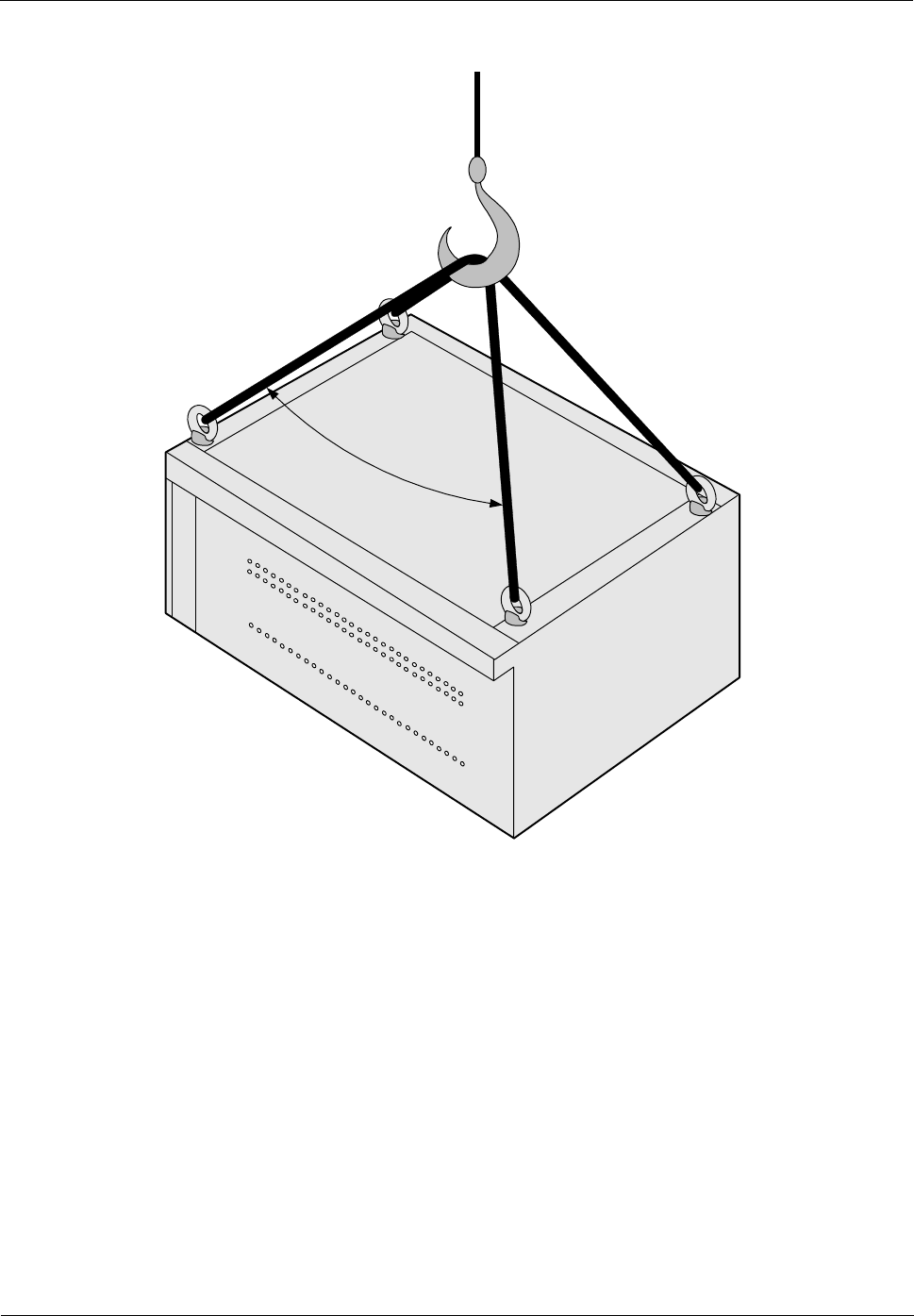
Huawei AR1200&AR2200&AR3200&AR3600 Series
Enterprise Routers
Safety and Regulatory Compliance Information
3 Safety Information
Issue 07 (2015-05-08)
Huawei Proprietary and Confidential
Copyright © Huawei Technologies Co., Ltd.
21
Figure 3-2 Weight lifting
3.6.2 Safety Guide on Ladder Use
Checking the Ladder
Before using the ladder, first check if the ladder is in good condition. Make sure that you
know the maximum weight that the ladder can support; overweight on the ladder is strictly
prohibited.
Placing the Ladder
Slant angle is suggested to be 75 degrees. The slant can be measured with the angle square or
with arms. When using a ladder, place the wider end of the ladder on the ground. Otherwise,
take protective measures on the base part of the ladder to avoid skidding. Place the ladder on
stable ground.
Maximum 90
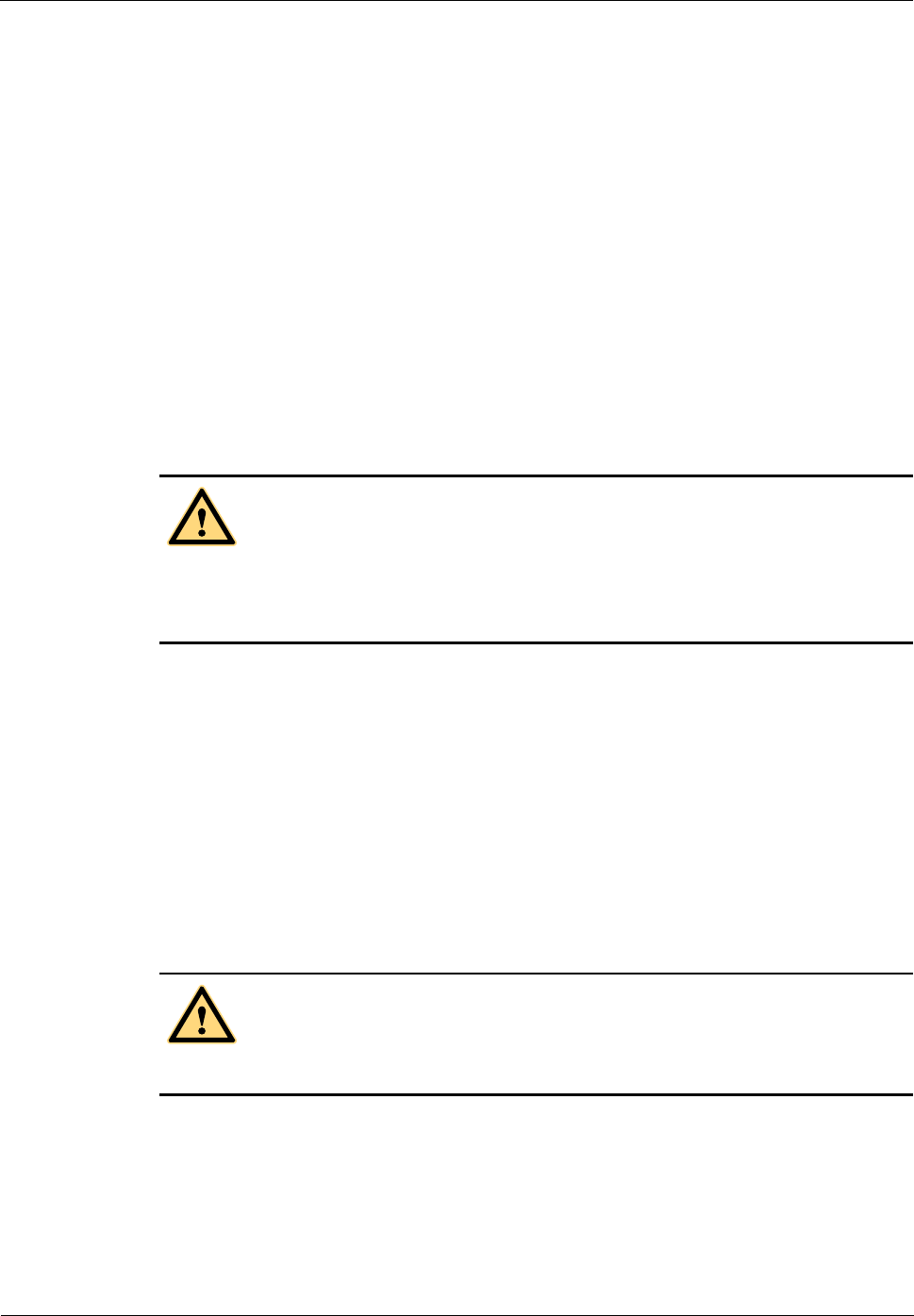
Huawei AR1200&AR2200&AR3200&AR3600 Series
Enterprise Routers
Safety and Regulatory Compliance Information
3 Safety Information
Issue 07 (2015-05-08)
Huawei Proprietary and Confidential
Copyright © Huawei Technologies Co., Ltd.
22
Climbing the Ladder
When climbing the ladder, note the following.
Ensure the gravity center of your body does not deviate from the ladder edge.
To lessen the danger and ensure the safety, hold your balance on the ladder before any
operation.
Do not climb higher than the fourth highest step of the ladder.
If you are about to climb to the top, the length of the ladder shall be one meter higher
than the eave.
3.7 Mechanical Safety
3.7.1 Drilling
Drilling on the rack without permission is strictly prohibited. Drilling that does not satisfy the
requirements concerned may damage the wires and cables inside the rack. If the metal
shavings from the drilling fall into the rack, it may result in short circuit of the circuit boards.
Before drilling a hole on the rack, wear insulation gloves, and remove the cables inside
the rack.
During the drilling, ensure that your eyes are well protected. The hot shavings may
injury to your eyes.
Ensure that the metal shavings do not get into the rack.
Non-standard drilling may damage the electromagnetic shielding performance of the
rack.
After drilling, clean the metal shavings in time.
3.7.2 Sharp Objects
When carrying the device by hand, wear protection gloves to avoid injury by sharp objects.
3.7.3 Handling Fans
Ensure the following:
When replacing a component, place the component, screw, and tool at a safe place to
prevent them from falling into the running fan.
WARNING
WARNING
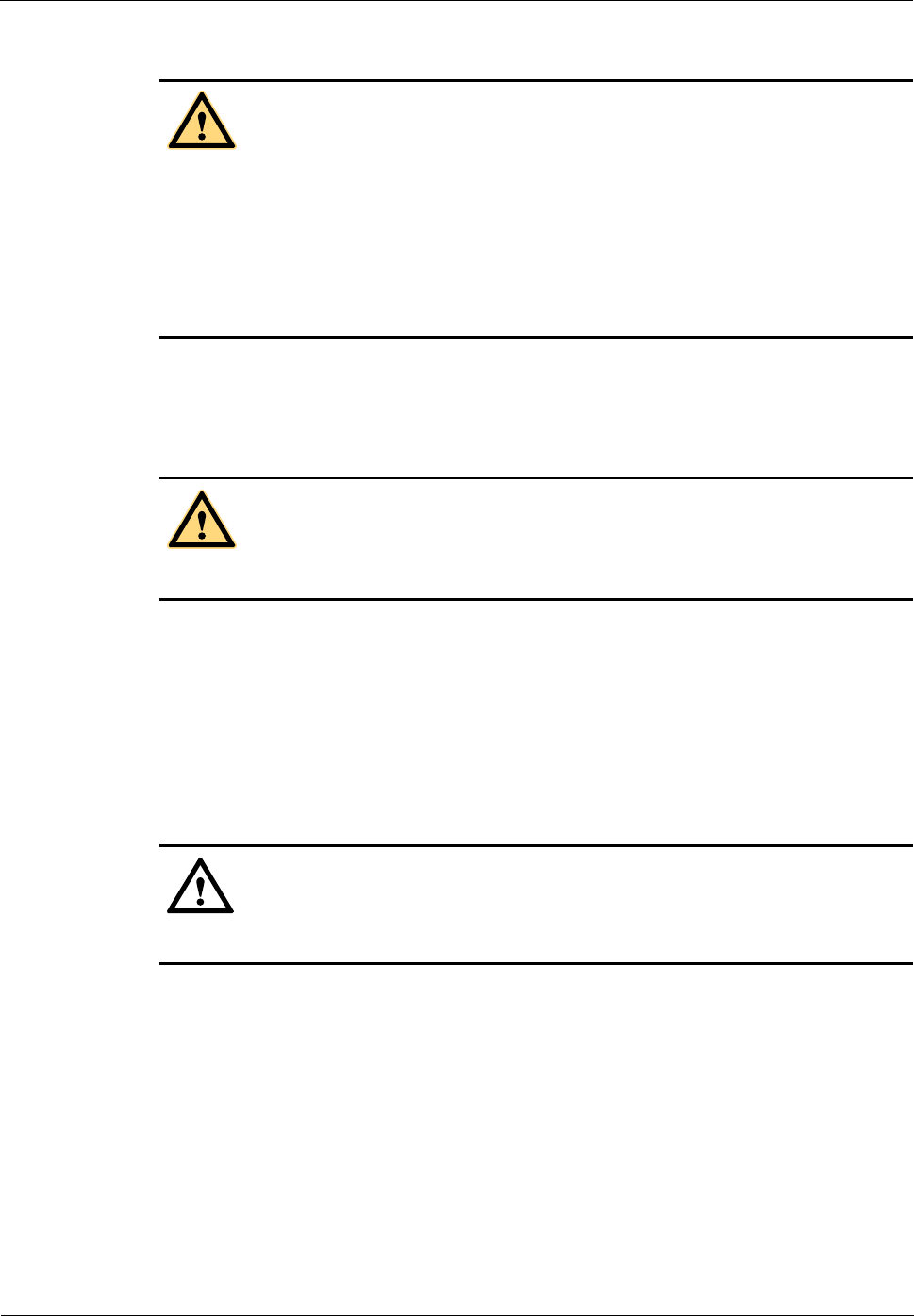
Huawei AR1200&AR2200&AR3200&AR3600 Series
Enterprise Routers
Safety and Regulatory Compliance Information
3 Safety Information
Issue 07 (2015-05-08)
Huawei Proprietary and Confidential
Copyright © Huawei Technologies Co., Ltd.
23
When replacing the ambient equipment around the fan, do not place the finger or board
into the running fan until the fan is switched off and stops running.
Only Huawei can open the device shell to maintain the fans.
Disconnect the power source prior to open case, and close case before restoring power
which stated in the instruction.
Failure unit should be sent back to the manufacturer for repair by skilled person which
stated in the instruction.
3.7.4 Lifting Heavy Objects
When lifting heavy objects, do not stand or walk under the arm or the lifted object.
3.8 Miscellaneous
3.8.1 Inserting and Removing a Board
To insert or remove a board, abide by the following requirements:
When inserting a board, handle it gently to avoid distorting pins on the backplane.
Insert the board along the slot guide.
The two sides of one board should not contact another board to avoid short-circuit or
scratch.
When holding a board in hand, do not touch the board circuit, components, connectors,
or connection slots.
3.8.2 Bundling Signal Cables
WARNING
WARNING
CAUTION
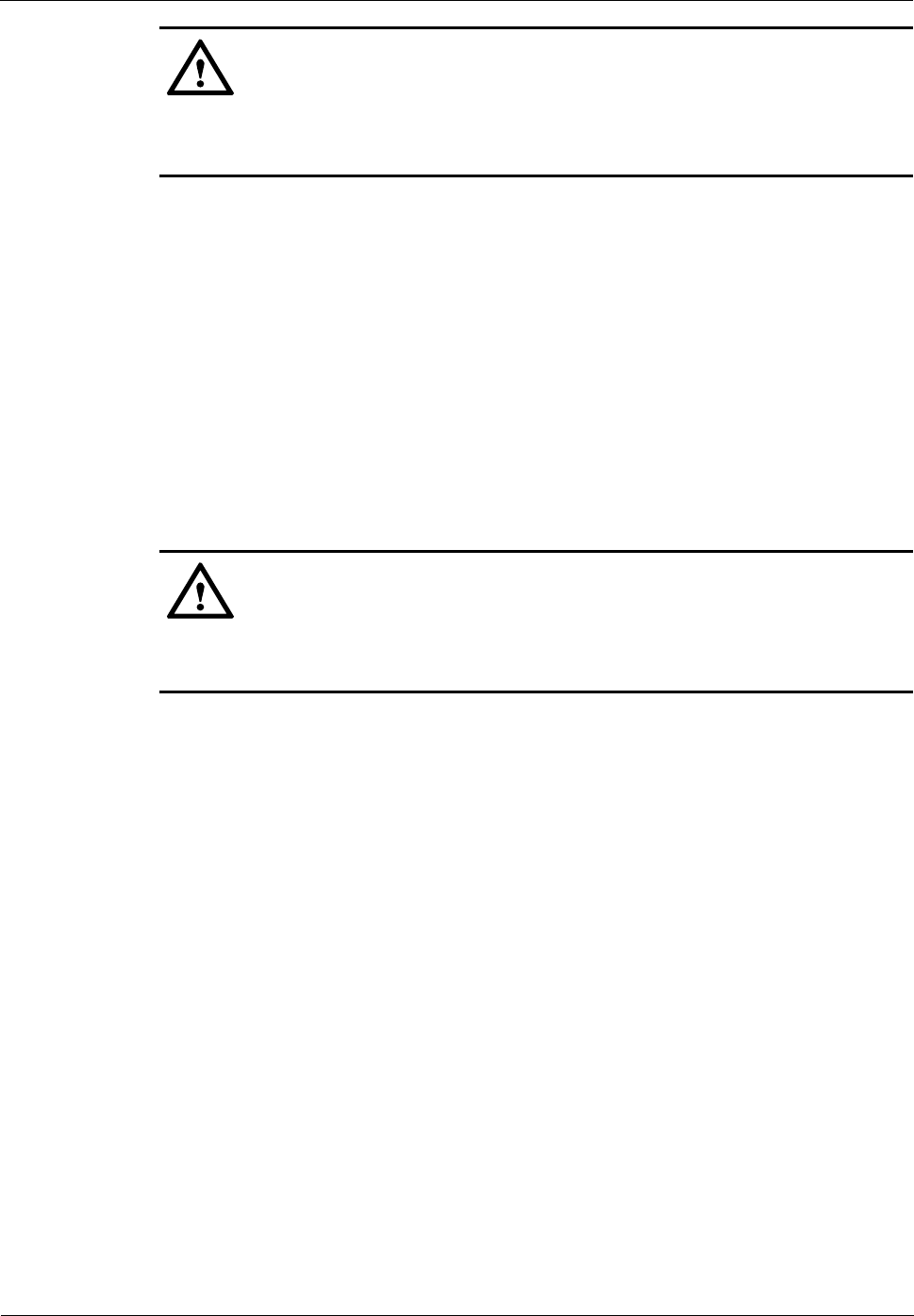
Huawei AR1200&AR2200&AR3200&AR3600 Series
Enterprise Routers
Safety and Regulatory Compliance Information
3 Safety Information
Issue 07 (2015-05-08)
Huawei Proprietary and Confidential
Copyright © Huawei Technologies Co., Ltd.
24
Bundle the signal cables separately from the strong current cables or high voltage cables.
Maintain a minimum space of 150 mm between adjacent ties.
3.8.3 Cabling Requirements
At a very low temperature, movement of the cable may damage the plastic skin of the cable.
To ensure the construction safety, comply with the following requirements:
When installing cables, ensure that the environment temperature is above 0°C.
If cables are stored in the place below 0°C, move the cables into a place at a room
temperature and store the cables for more than 24 hours before installation.
Move the cables with care, especially at a low temperature. Do not drop the cables
directly from the vehicle.
3.9 3G Antenna
The product uses standard 3G antenna. Only qualified personnel can install and maintain
the antennas.
CAUTION
CAUTION

Huawei AR1200&AR2200&AR3200&AR3600 Series
Enterprise Routers
Safety and Regulatory Compliance Information
4 Sicherheitsinformationen
Issue 07 (2015-05-08)
Huawei Proprietary and Confidential
Copyright © Huawei Technologies Co., Ltd.
25
4 Sicherheitsinformationen
Über dieses Kapitel
In der folgenden Tabelle ist der Inhalt dieses Kapitels aufgeführt.
Titel
Beschreibung
4.1 Überblick
Sicherheitsvorkehrungen, die vor der Installation und
Wartung des Huawei-Geräts ergriffen werden müssen.
4.2 Elektrische Sicherheit
Informationen über die elektrische Sicherheit.
4.3 Feuergefährliche
Umgebung
Informationen über die Sicherheit feuergefährlicher
Umgebungen.
4.4 Batterie
Informationen über die Sicherheit der Batterie.
4.5 Laser
Sicherheitsmaßnahmen, wenn das Gerät und der Laser
elektromagnetischen Feldern ausgesetzt sind.
4.6 Arbeiten in großen Höhen
Sicherheitsmaßnahmen, die vor Verwendung von Leitern
oder vor dem Heben schwerer Gegenstände ergriffen
werden müssen.
4.7 Mechanische Sicherheit
Sicherheitsmaßnahmen beim Bohren, bei scharfkantigen
Gegenständen, beim Umgang mit Lüftern und beim
Heben schwerer Gegenstände.
4.8 Verschiedenes
Sicherheitsmaßnahmen beim Einsetzen und Entfernen
von Leiterplatten, beim Bündeln von Signalleitungen
sowie Verkabelungsanforderungen.

Huawei AR1200&AR2200&AR3200&AR3600 Series
Enterprise Routers
Safety and Regulatory Compliance Information
4 Sicherheitsinformationen
Issue 07 (2015-05-08)
Huawei Proprietary and Confidential
Copyright © Huawei Technologies Co., Ltd.
26
4.1 Überblick
4.1.1 Sicherheitsmaßnahmen
Dieser Abschnitt beschreibt die Sicherheitsvorkehrungen, die vor der Installation und Wartung
des Huawei-Geräts ergriffen werden müssen.
Lesen Sie vor der Durchführung von Arbeiten die Bedienungsanleitung und die zu
ergreifenden Vorsichtsmaßnahmen durch und befolgen Sie sie, um Unfälle zu verhindern.
Die in anderen Dokumenten aufgeführten Symbole für Achtung, Warnung und Gefahr
beinhalten nicht alle zu beachtenden Sicherheitsvorschriften. Sie dienen nur als
Zusatzinformationen. Das Installations- und Wartungspersonal muss die grundlegenden
Sicherheitsmaßnahmen kennen, die ergriffen werden müssen.
Beachten Sie beim Betrieb des Geräts die örtlichen Sicherheitsvorschriften. Die in diesen
Dokumenten angegebenen Sicherheitsmaßnahmen dienen nur als Ergänzung und müssen
den örtlichen Sicherheitsvorschriften entsprechen.
Befolgen Sie beim Betrieb des Huawei-Geräts neben den Vorsichtsmaßnahmen auch die
von Huawei angegebenen spezifischen Sicherheitsanweisungen.
Das Installations- und Wartungspersonal muss in den Sicherheitsmaßnahmen geschult
werden. Nur qualifiziertes Fachpersonal darf das Gerät installieren oder warten.
4.1.2 Allgemeine Anforderungen
Um das technische Restrisiko zu minimieren, müssen die folgenden Regeln befolgt werden.
Lesen Sie alle Anweisungen sorgfältig durch, bevor Sie mit dem Arbeiten beginnen.
Aufstellen
Das Gerät (oder das System) darf nur an Orten mit beschränktem Zugang aufgestellt
oder benutzt werden.
Seien Sie vorsichtig, da die Oberfläche des Geräts während des Betriebs heiß wird. Wenn
Sie die Oberfläche mit den Händen berühren oder den Griff des Geräts betätigen, sollten
Sie zum Schutz Handschuhe tragen.
Vor dem Betrieb muss das Gerät sicher auf dem Boden oder an anderen zuverlässigen
Gegenständen befestigt sein, zum Beispiel an Wänden oder Montagegestellen.
Beim Aufstellen der Einheit ist zuerst der Erdleiter anzuschließen. Beim Trennen ist er
als letzter zu entfernen.
Decken Sie Lüftungsöffnungen während des Betriebes nicht ab. Sorgen Sie für einen
Abstand der Belüftungsöffnungen von mindestens 5 cm von Wänden oder anderen
Gegenständen, die die Belüftung blockieren.
Flügelmuttern und -schrauben sind nach der Erstinstallation und nach Wiederanbringung
von Abdeckungen mit Hilfe von Werkzeug festzuziehen.
Erdung
Beschädigen Sie den Erdleiter nicht und betreiben Sie das Gerät niemals ohne Erdung.
Nehmen Sie Kontakt mit einem prüfenden Elektriker auf.
Das Gerät (oder das System) muss vor der Inbetriebnahme permanent geerdet werden.
Der Querschnitt des Schutzleiters muss mindestens 1,0 mm² betragen.

Huawei AR1200&AR2200&AR3200&AR3600 Series
Enterprise Routers
Safety and Regulatory Compliance Information
4 Sicherheitsinformationen
Issue 07 (2015-05-08)
Huawei Proprietary and Confidential
Copyright © Huawei Technologies Co., Ltd.
27
Energieversorgung
Mit Wechselstrom betriebenes Modell: Die Steckdose muss sich in der Nähe des Geräts
befinden und leicht zugänglich sein.
Mit Wechselstrom betriebenes Modell: Das Gerät arbeitet mit einem TN oder
TT-Stromversorgungssystem.
Für Modell mit DC: Verstärkte Isolierung oder doppelte Isolierung ist zur Isolierung der
DC-Quelle von der Wechselspannung notwendig.
Für Modell mit DC: Eine leicht zugängliche Abschaltmöglichkeit ist in der Verkabelung
zu integrieren.
Vorbereitete Leiter werden an den Klemmenblock angeschlossen und nur die
entsprechende AWG/Kabelart wird mit den Kabelschuhen gesichert.
Dieses Gerät benötigt eine Sicherung vor Kurzschluss (Überstrom) in der
Gebäudeinstallation. Stellen Sie sicher, dass die Sicherungswerte auf allen Phasenleitern
(alle stromführenden Leiter) nicht größer als 240 V AC, 20 A bei den mit Wechselstrom
betriebenen Modellen sowie 80 VDC, 10 A bei den mit Gleichstrom betriebenen
Modellen sind.
Mit Wechselstrom betriebenes Modell: Die Stecker-Steckdosen-Verbindung muss
jederzeit zugänglich sein, da sie die Netztrennstelle ist.
Das Gerät hat mehrere Energiequellen, daher ist es notwendig, stets alle Verbindungen
zu unterbrechen, um den energiefreien Zustand zu erreichen.
Das mit Wechselstrom betriebene Modell hat eine Zweiphasen-Sicherung.
Um die Brandgefahr zu minimieren, dürfen ausschließlich Nr. 26 AWG oder
leistungsfähigere Telekommunikationskabel verwendet werden.
Personensicherheit
Betreiben Sie das Gerät und die Kabel nicht während eines Gewitters.
Um einen elektrischen Schlag zu vermeiden, dürfen Kleinspannungsschaltungen (SELV)
nicht mit Telefonnetzwerken (TNV) verbunden werden.
Blicken Sie nicht direkt in den optischen Anschluss, da die Laserstrahlung zu
Augenverletzungen führen kann.
Tragen Sie keinen Schmuck oder Uhren, wenn Sie am Gerät arbeiten.
Bediener
Das Gerät darf nur von qualifiziertem Fachpersonal installiert, konfiguriert und zerlegt
werden.
Das Gerät darf nur von autorisierten Personen betrieben werden.
Ein Austausch oder eine Änderung des Geräts oder der Teile des Geräts (einschl. der
Software) darf nur von qualifiziertem Fachpersonal oder von Personen durchgeführt
werden, die von Huawei autorisiert sind.
Jeder Fehler und jede Störung, die die Sicherheit verletzen könnten, sind sofort den
verantwortlichen Personen zu melden.
Nur qualifiziertes Fachpersonal darf Sicherheitseinrichtungen beseitigen oder außer
Betrieb setzen, und Fehlersuche oder Wartungsarbeiten durchführen.
Lesen und befolgen Sie alle Anweisungen sorgfältig, bevor Sie mit dem Arbeiten beginnen.
Das Dokument enthält auch Richtlinien zur Auswahl der Mess- und Prüfinstrumente.
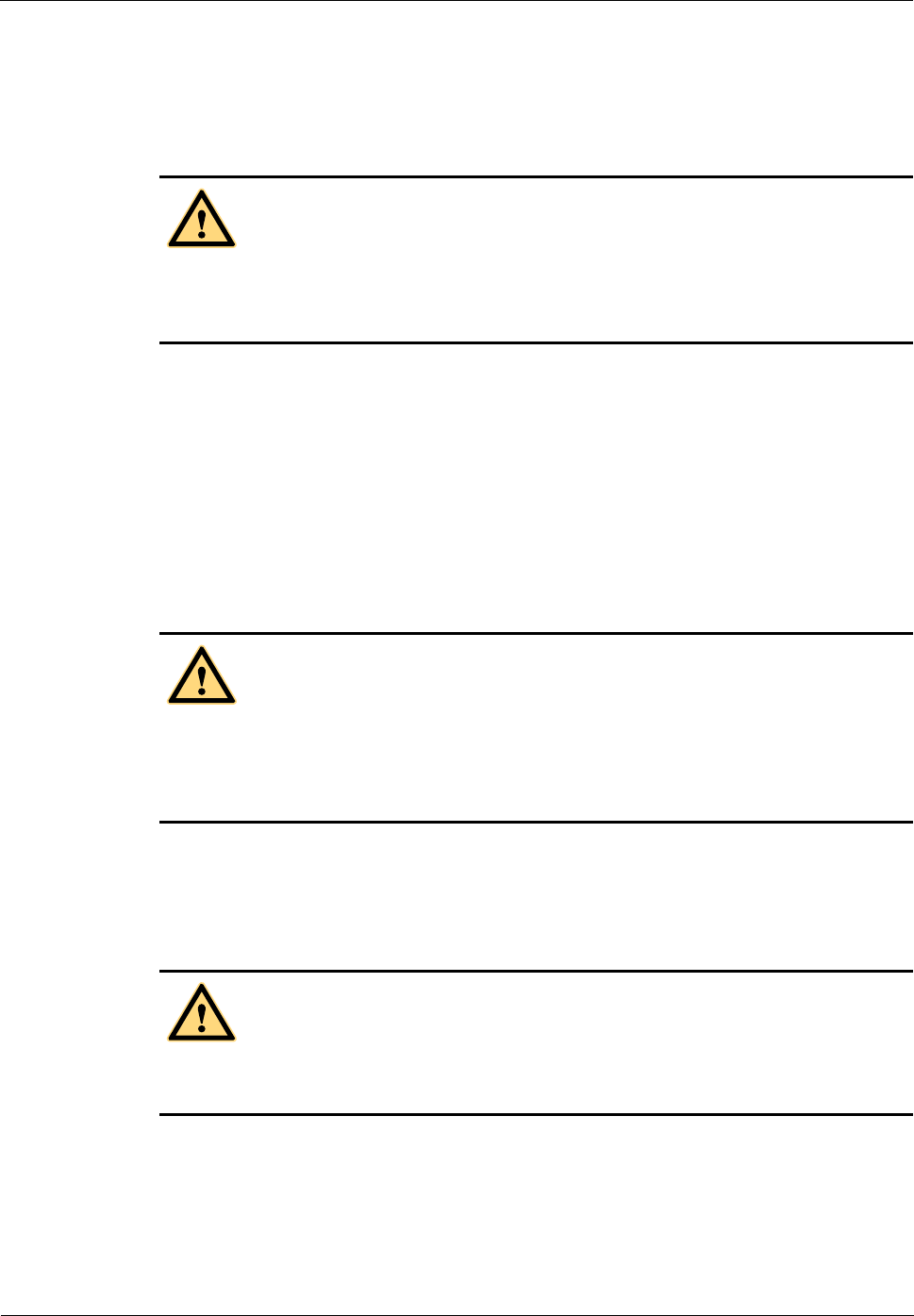
Huawei AR1200&AR2200&AR3200&AR3600 Series
Enterprise Routers
Safety and Regulatory Compliance Information
4 Sicherheitsinformationen
Issue 07 (2015-05-08)
Huawei Proprietary and Confidential
Copyright © Huawei Technologies Co., Ltd.
28
4.2 Elektrische Sicherheit
4.2.1 Hochspannung
Hochspannungsleitungen stellen die für den Betrieb des Geräts erforderliche Energie zur
Verfügung. Direkter oder indirekter Kontakt (durch feuchte Gegenstände) mit Hochspannung
und Wechselstromversorgung kann zu tödlichen Unfällen führen.
Während des Aufstellens der Wechselstromversorgungseinheit sind die lokalen
Sicherheitsvorschriften einzuhalten. Das Personal für das Aufstellen der Wechselstromeinheit
muss für Arbeiten an Hochspannung und Wechselstrom qualifiziert sein.
Tragen Sie während der Arbeiten keine leitfähigen Gegenstände wie Uhren, Armreifen,
Ketten oder Ringe.
Sollte sich Wasser im Gestell befinden oder das Gestell feucht sein, ist die Energiezufuhr
sofort zu unterbrechen.
Stellen Sie sicher, dass das Gerät trocken ist, wenn die Arbeiten in einer feuchten
Umgebung durchgeführt werden.
Die Nichtbeachtung der Sicherheitsvorschriften bei der Arbeit mit Hochspannung kann zu
Feuer und elektrischem Schlag führen. Deshalb muss die Verlegung von Leitungen und
Verbindungen den örtlichen Anforderungen und Sicherheitsvorschriften entsprechen. Arbeiten
mit Hochspannung dürfen nur von qualifiziertem Fachpersonal durchgeführt werden.
4.2.2 Gewitter
Hochspannung und Betrieb mit Wechselstrom oder Arbeiten auf einem Stahlturm und -mast
sind während Gewittern verboten.
Das elektromagnetische Feld, das während eines Gewitters entsteht, kann die Elektronik
beschädigen. Um die Ausrüstung vor Beschädigung durch Blitzschlag zu schützen, ist eine
ordnungsgemäße Erdung erforderlich.
GEFAHR
WARNUNG
GEFAHR
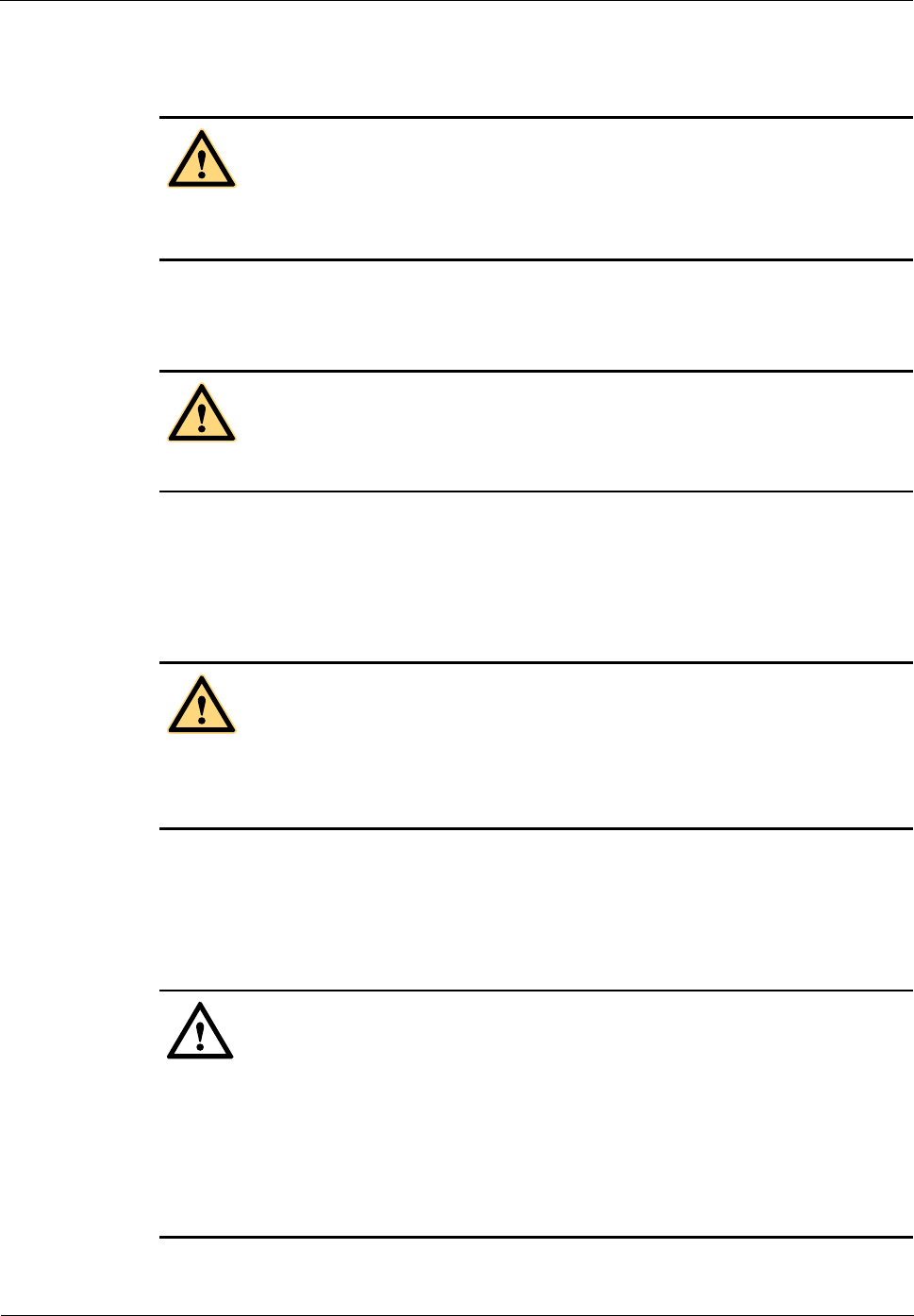
Huawei AR1200&AR2200&AR3200&AR3600 Series
Enterprise Routers
Safety and Regulatory Compliance Information
4 Sicherheitsinformationen
Issue 07 (2015-05-08)
Huawei Proprietary and Confidential
Copyright © Huawei Technologies Co., Ltd.
29
4.2.3 Werkzeuge
Vorschlag: Für Arbeiten mit Hochspannung und Wechselstrom sind Spezialwerkzeuge zu
verwenden. Normale Werkzeuge dürfen nicht verwendet werden.
4.2.4 Hoher Kriechstrom
Erden Sie das Gerät bevor Sie es anschalten. Es besteht sonst Gefahr für Menschen und das Gerät.
Wenn sich die Markierung „hoher Kriechstrom" am Leistungsanschluss des Gerätes befindet,
müssen Sie das Gerät erden, bevor Sie es anschalten.
4.2.5 Zuleitung
Eine Installation und ein Entfernen stromführender Leitungen ist verboten. Kurzschlüsse
zwischen innerem und äußerem Leiter können Lichtbögen oder Funkenflug verursachen, was
zu Feuer oder einer Augenverletzung führen kann.
Das System muss stets abgeschaltet werden, bevor die Zuleitung angebracht oder
entfernt wird.
Überprüfen Sie vor dem Anbringen der Zuleitung immer, ob das von Ihnen verwendete
Kabel den Anforderungen entspricht.
Verwenden Sie für ein mit Gleichstrom betriebenes Gerät ein Stromversorgungskabel mit
mind. 1,0 mm² oder 16 AWG.
Verwenden Sie für ein mit Wechselstrom betriebenes Gerät ein Stromversorgungskabel mit
mind. 1,0 mm² oder 16 AWG.
Es sind Typ H03VVF oder eine leichte PVC-Schlauchleitung entsprechend IEC 60227 zu
benutzen.
WARNUNG
WARNUNG
WARNUNG
VORSICHT
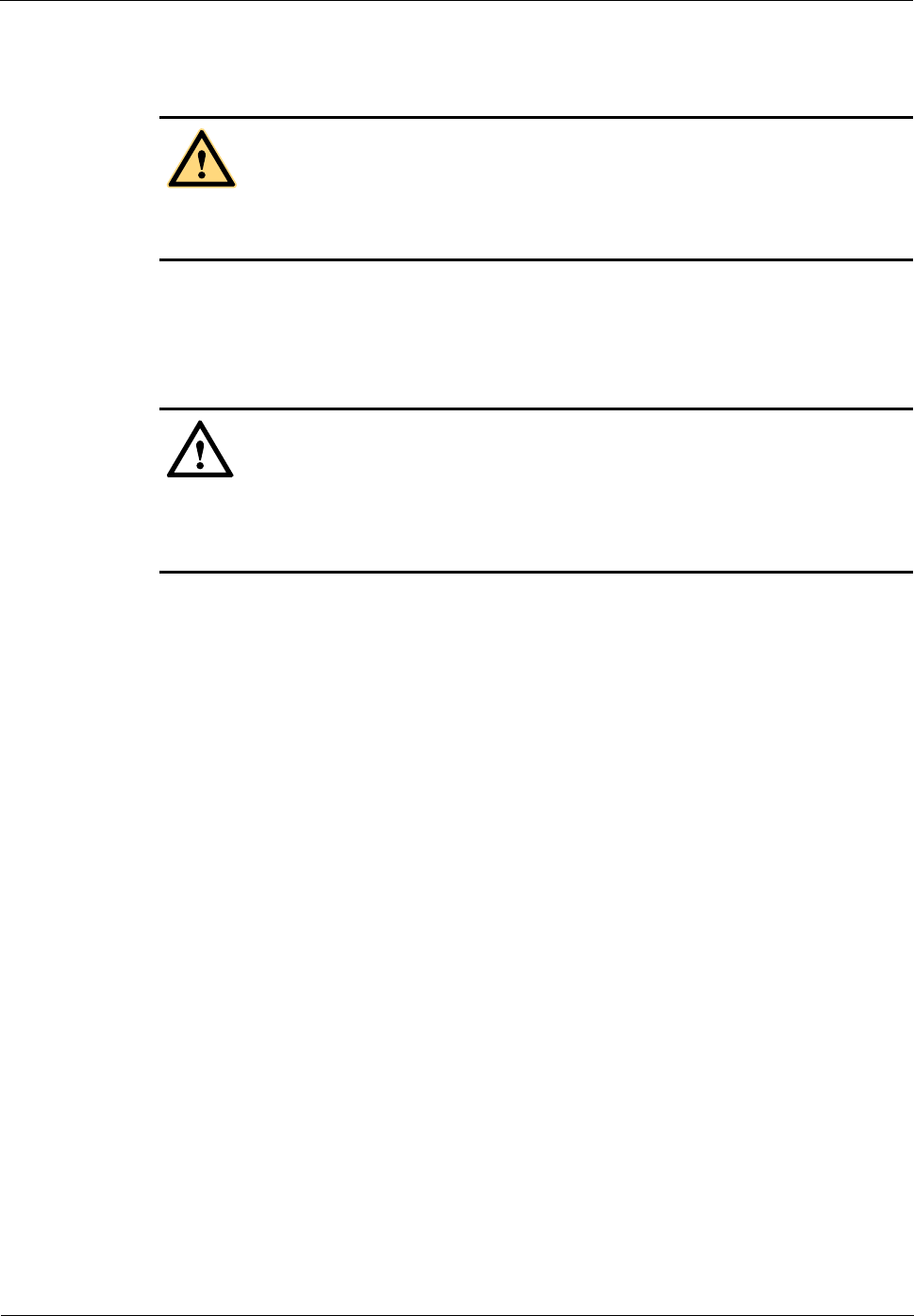
Huawei AR1200&AR2200&AR3200&AR3600 Series
Enterprise Routers
Safety and Regulatory Compliance Information
4 Sicherheitsinformationen
Issue 07 (2015-05-08)
Huawei Proprietary and Confidential
Copyright © Huawei Technologies Co., Ltd.
30
4.2.6 Sicherung
Ersetzen Sie die Sicherung bei Bedarf immer nur mit einem Sicherungstyp, der die gleichen
technischen Daten besitzt.
4.2.7 Elektrostatische Entladung
Die vom menschlichen Körper erzeugte elektrostatische Elektrizität kann sensible
elektrostatische Bauteile auf der Leiterplatte beschädigen, zum Beispiel integrierte
Schaltkreise (ICs).
Der menschliche Körper erzeugt in den folgenden Situationen ein statisches
elektromagnetisches Feld:
Bei Bewegung
Durch Reibung der Kleidung
Durch Reibung zwischen den Schuhen und dem Boden
Beim Halten von normalem Kunststoff in der Hand
Das statische elektromagnetische Feld bleibt lange Zeit im Körper.
Tragen Sie beim Berühren des Geräts, mit der Hand zu bedienenden Teilen, Leiterplatten oder
ASICs ein geerdetes Armband zur elektrostatischen Entladung (ESD). Dies kann verhindern,
dass empfindliche Bauteile durch statische Elektrizität im menschlichen Körper beschädigt
werden.
WARNUNG
VORSICHT
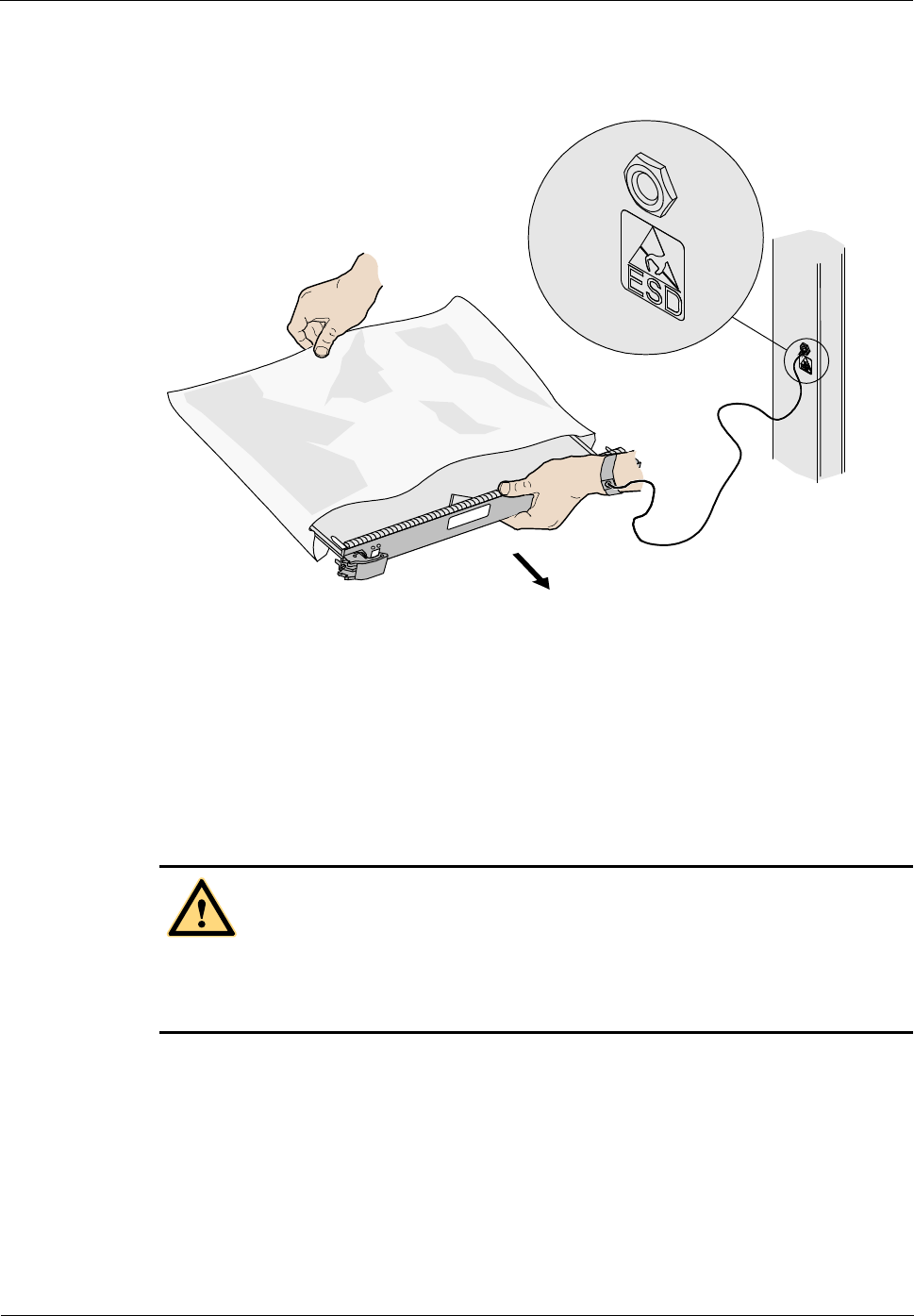
Huawei AR1200&AR2200&AR3200&AR3600 Series
Enterprise Routers
Safety and Regulatory Compliance Information
4 Sicherheitsinformationen
Issue 07 (2015-05-08)
Huawei Proprietary and Confidential
Copyright © Huawei Technologies Co., Ltd.
31
Figure 4-1 zeigt das Tragen eines ESD-Armbandes.
Figure 4-1 Tragen eines ESD-Armbandes
4.3 Feuergefährliche Umgebung
Jegliches Betreiben des elektrischen Gerätes in einer feuergefährlichen Umgebung verursacht
Gefahr.
Stellen Sie das Gerät nicht bei Umgebungsbedingungen auf, wo brennbare und explosive
Luft oder Gase vorherrschen. Nehmen Sie bei diesen Umgebungsbedingungen das Gerät nicht
in Betrieb.
GEFAHR
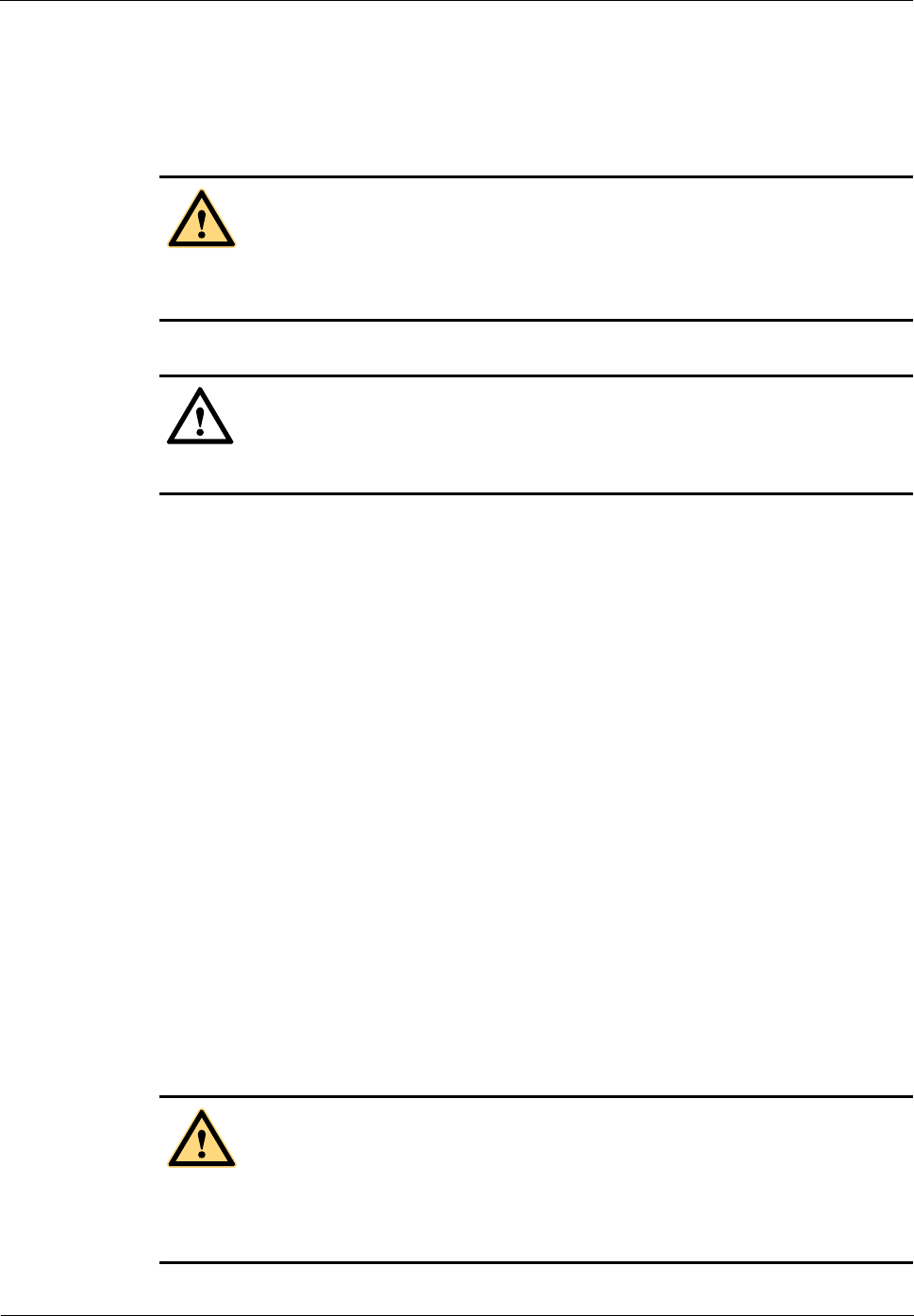
Huawei AR1200&AR2200&AR3200&AR3600 Series
Enterprise Routers
Safety and Regulatory Compliance Information
4 Sicherheitsinformationen
Issue 07 (2015-05-08)
Huawei Proprietary and Confidential
Copyright © Huawei Technologies Co., Ltd.
32
4.4 Batterie
4.4.1 Speicherbatterie
Lesen Sie vor dem Umgang mit der Batterie die Sicherheitsmaßnahmen sorgfältig durch, die
beim Umgang mit der Batterie und beim Anschließen ergriffen werden sollen.
Nicht vorschriftsgemäße Arbeiten an den Batterien können Gefahren beinhalten.
Während des Betriebs:
Schützen Sie die Batterie vor Kurzschluss.
Verhindern Sie Überlaufen und Auslaufen der Elektrolytflüssigkeit.
Das Überlaufen von Elektrolytflüssigkeit kann das Gerät beschädigen. Es kann Metallteile
und die Leiterplatten korrodieren und das Gerät beschädigen, sowie zu Kurzschlüssen in den
Leiterplatten führen.
Allgemeiner Betrieb
Beachten Sie Folgendes während der Montage und Wartung von Batterien:
Tragen Sie keine metallischen Gegenstände wie Uhren, Armreifen, Ketten und Ringe.
Benutzen Sie isoliertes Spezialwerkzeug.
Tragen Sie eine Schutzbrille während der Bedienung des Geräts.
Tragen Sie Gummihandschuhe und eine Schürze für den Fall des Überlaufens von
Elektrolytflüssigkeit.
Halten Sie die Elektrode beim Umgang mit der Batterie immer senkrecht vor sich.
Drehen Sie Batterie nicht um und kippen Sie sie nicht.
Kurzschluss
Der Kurzschluss der Batterie kann Verletzungen zur Folge haben. Auch wenn die Spannung
einer normalen Batterie gering ist, setzt hoher Übergangsstrom, der durch einen Kurzschluss
verursacht wird, eine große Menge Energie frei.
GEFAHR
VORSICHT
WARNUNG
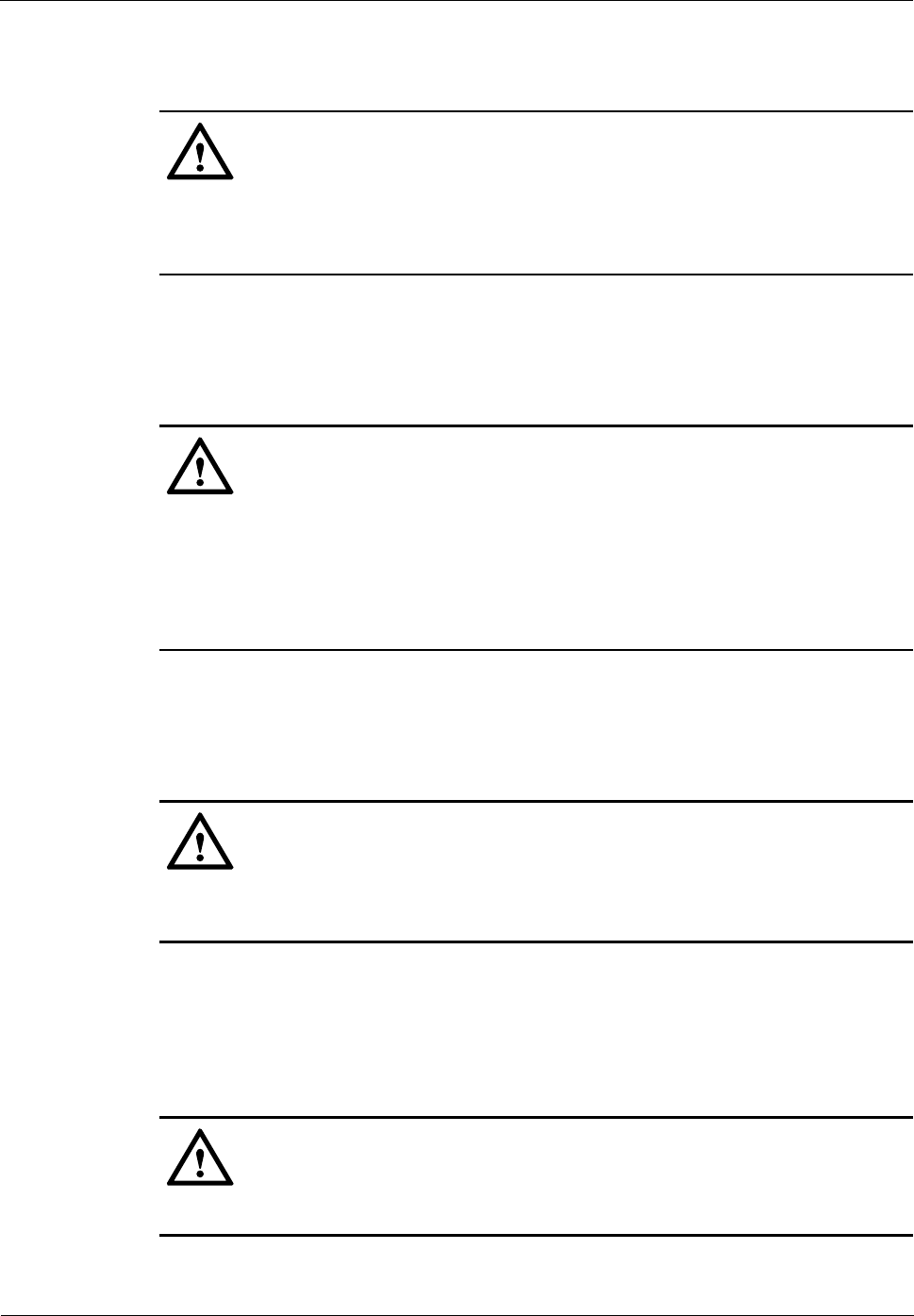
Huawei AR1200&AR2200&AR3200&AR3600 Series
Enterprise Routers
Safety and Regulatory Compliance Information
4 Sicherheitsinformationen
Issue 07 (2015-05-08)
Huawei Proprietary and Confidential
Copyright © Huawei Technologies Co., Ltd.
33
Bei unsachgemäßem Einsetzen der Batterie besteht die Gefahr einer Explosion. Ersetzen Sie
die Batterie daher nur mit dem gleichen oder einem ähnlichem, vom Hersteller empfohlenen
Batterietyp.
Halten Sie metallische Gegenstände von der Batterie fern, die einen Kurzschluss verursachen
könnten. Wenn sie verwendet werden müssen, trennen Sie zuerst die verwendeten Batterien,
bevor Sie andere Arbeiten durchführen.
Gefährliches Gas
Verwenden Sie keine unversiegelten Bleisäurebatterien, da das Gas, das von der Batterie
abgegeben wird, zu einem Feuer oder einer Korrosion des Geräts führen kann.
Legen Sie die Batterie horizontal hin und befestigen Sie sie richtig.
Die verwendete Batterie gibt brennbares Gas ab. Stellen Sie die Batterie deshalb an einem
Ort mit guter Belüftung auf und ergreifen Sie Vorsichtsmaßnahmen gegen Feuer.
Hohe Temperatur
Hohe Temperatur kann zu einem Verziehen, Schaden oder Überlaufen der
Elektrolytflüssigkeit der Batterie führen.
Wenn die Temperatur der Batterie 60 C übersteigt, sollten Sie prüfen, ob Säureflüssigkeit
überläuft. Falls Säureflüssigkeit überläuft, beseitigen Sie die Säureflüssigkeit sofort.
Säureflüssigkeit
Falls Säureflüssigkeit überläuft, absorbieren und neutralisieren Sie die Flüssigkeit sofort.
VORSICHT
VORSICHT
VORSICHT
VORSICHT
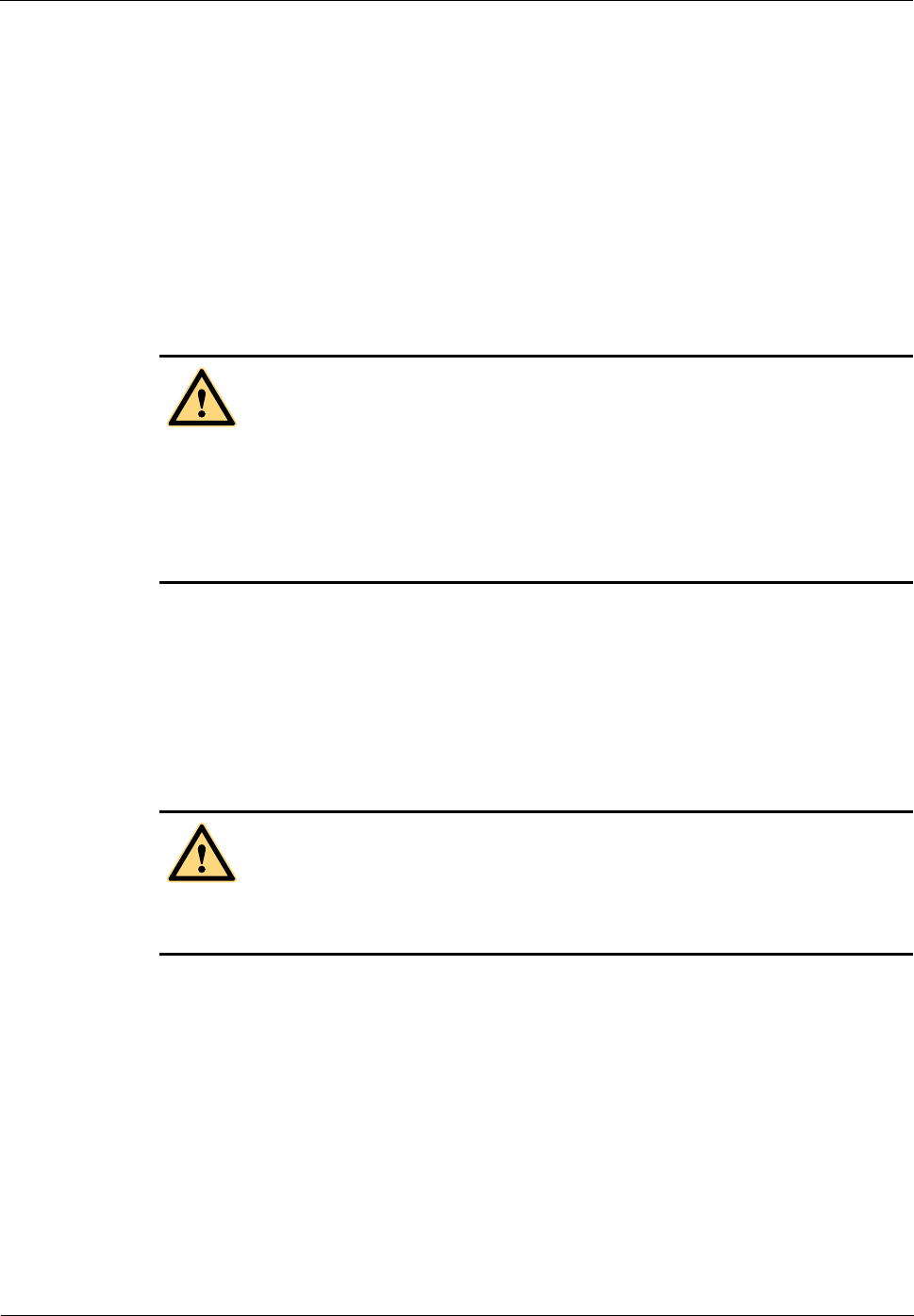
Huawei AR1200&AR2200&AR3200&AR3600 Series
Enterprise Routers
Safety and Regulatory Compliance Information
4 Sicherheitsinformationen
Issue 07 (2015-05-08)
Huawei Proprietary and Confidential
Copyright © Huawei Technologies Co., Ltd.
34
Beachten Sie beim Bewegen oder Entfernen einer auslaufenden Batterie den möglichen
Schaden, der durch die Säureflüssigkeit verursacht werden kann. Wenn Sie verschüttete
Säureflüssigkeit gefunden haben, verwenden Sie die folgenden Materialien, um sie zu
absorbieren und zu neutralisieren.
Natriumbikarbonat (Backpulver): NaHCO3
Natriumkarbonat (Soda): Na2CO3
Bei Verwendung von säurebindenden Mitteln müssen die Anweisungen des
Batterielieferanten befolgt werden.
4.4.2 Lithium-Batterie
Bei unsachgemäßem Einsetzen der Batterie besteht die Gefahr einer Explosion. Ersetzen
Sie die Batterie daher nur mit dem gleichen oder einem ähnlichem, vom Hersteller
empfohlenen Batterietyp.
Entsorgen Sie verbrauchte Batterien gemäß den Anweisungen des Herstellers.
Verbrennen Sie Lithium-Batterien nicht.
4.5 Laser
Die von diesem Laser ausgehende Gefahr entspricht der Klasse 1.
Halten Sie bei der Handhabung von optischen Fasern Abstand und schauen Sie nicht ohne
Augenschutz in das Ende von optischen Fasern.
4.5.1 Allgemeine Informationen zum Laser
Lasersender und -empfänger werden in optischen Übertragungs- und Überwachungssystemen
eingesetzt. Die Wellenlänge des Lasers beträgt zwischen 780 nm und 1600 nm. Die
Laserenergie, die durch optische Fasern übertragen wird, hat eine sehr hohe Energiedichte.
Das Laserlicht ist aber nicht sichtbar für das menschliche Auge. Wenn ein Lichtstrahl in das
Auge eindringt, kann die Retina beschädigt werden.
Bei der im Telekommunikationsbereich genutzten Wellenlänge von Lasern kann die Retina
durch Wärme geschädigt werden.
WARNUNG
WARNUNG

Huawei AR1200&AR2200&AR3200&AR3600 Series
Enterprise Routers
Safety and Regulatory Compliance Information
4 Sicherheitsinformationen
Issue 07 (2015-05-08)
Huawei Proprietary and Confidential
Copyright © Huawei Technologies Co., Ltd.
35
Laser, die in Lichtwellenleitersystemen verwendet werden, weisen eine größere Streuung des
Lichtstrahls auf, typisch sind Werte zwischen 10° und 20°. Der versehentliche Blick in eine
beschädigte oder nicht abgeschlossene optische Faser ohne Augenschutz aus einer Entfernung
von mehr als 150 mm verursacht keine Verletzung der Augen. Es kann aber zu
Augenverletzungen kommen, wenn optische Instrumente, wie z. B. ein Mikroskop,
Vergrößerungsglas oder eine Lupe verwendet werden, um das spannungsführende Faserende
zu betrachten.
Im normalen Betriebszustand ist ein LWL-System komplett abgeschlossen und stellt keine
Gefahr von Augenverletzungen dar. Zusätzliche Sicherheit wird durch eine automatische
Laserabschaltung (ALS) des Systems erreicht werden. Die ALS kann jedoch nur für
bidirektionale Übertragung angewendet werden. Wenn die Empfängerseite den Laser von der
Senderseite nicht erkennt, gibt er ein Signal an die Senderseite aus. Die ALS beendet die
Lasersendung in weniger als 100 ms nach Erhalt des Signals.
4.5.2 Sicherheitsrichtlinien für Laser
Beachten Sie die folgenden Richtlinien, um Laserstrahlung zu vermeiden:
Lesen Sie alle Anweisungen, bevor Sie das Gerät installieren, warten und in Betrieb
nehmen. Die Nichtbeachtung dieser Anweisungen kann zu gefährlicher Laserstrahlung
führen.
Tragen Sie während des Umgangs mit den optischen Fasern oder mit dem Laser eine
Schutzbrille.
Die Bedienung darf nur durch Personal erfolgen, das die entsprechenden Schulungen
absolviert hat.
Vergewissern Sie sich, dass die optische Quelle abgeschaltet ist, bevor Sie die
Verbindungen der optischen Fasern abklemmen.
Bevor Sie die vordere Tür eines optischen Übertragungssystems öffnen, müssen Sie
sicherstellen, dass Sie keiner Laserstrahlung ausgesetzt werden können.
Sehen Sie niemals in das Ende einer freigelegten Faser oder in eine offene Verbindung,
wenn Sie nicht sicher sind, dass die optische Quelle auch tatsächlich abgeschaltet ist.
Messen Sie mit einem optischen Leistungsmesser die optische Leistung, um festzustellen,
ob die optische Quelle ausgeschaltet ist.
Benutzen Sie keine optischen Instrumente, wie z. B. ein Mikroskop, Vergrößerungsglas
oder eine Lupe, um die Fasern oder die Verbindungen anzusehen.
4.5.3 Umgang mit Fasern
Lesen Sie die Anweisungen, bevor Sie mit den Fasern arbeiten.
Schneiden und Verbinden von Fasern darf nur von geschultem Personal durchgeführt
werden.
Vergewissern Sie sich stets vor dem Trennen und Verbinden von Fasern, dass diese auch
wirklich von der optischen Quelle getrennt wurden. Nach dem Abklemmen der Fasern
müssen alle optischen Verbindungen durch spezielle Verschlusskappen geschützt werden.
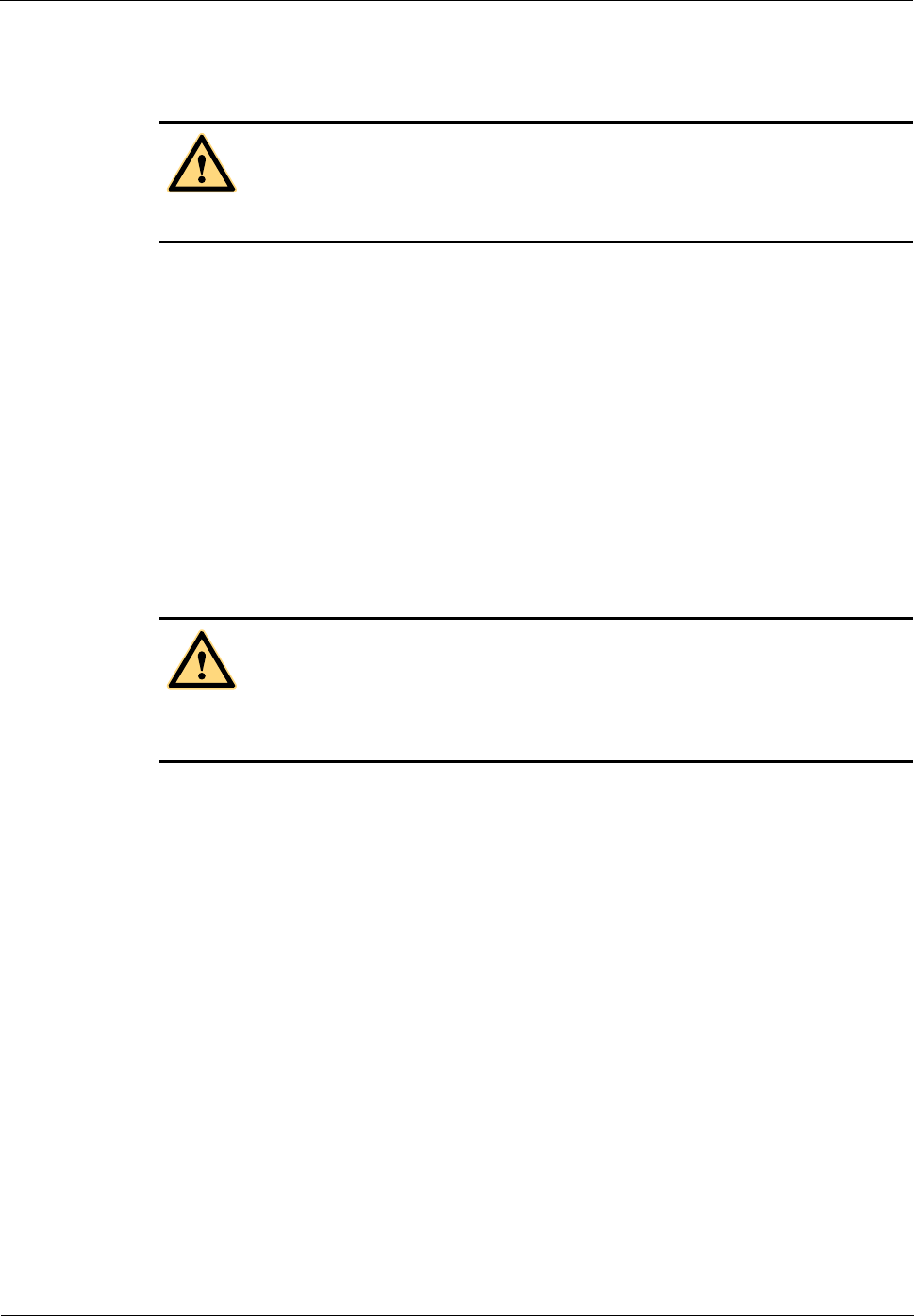
Huawei AR1200&AR2200&AR3200&AR3600 Series
Enterprise Routers
Safety and Regulatory Compliance Information
4 Sicherheitsinformationen
Issue 07 (2015-05-08)
Huawei Proprietary and Confidential
Copyright © Huawei Technologies Co., Ltd.
36
4.6 Arbeiten in großen Höhen
Achten Sie beim Arbeiten in großen Höhen darauf, dass keine Gegenstände herunterfallen.
Bei Arbeiten in großen Höhen sind folgende Anforderungen einzuhalten.
Das in großer Höhe arbeitende Personal muss geschult sein.
Der Betrieb von Maschinen und Werkzeugen muss sicher ausgeführt werden, um ein
Herunterfallen zu vermeiden.
Es müssen Sicherheitsmaßnahmen ergriffen werden, zum Beispiel das Tragen eines
Helms und eines Sicherheitsgurts.
Tragen Sie in kalten Gegenden warme Kleidung, wenn Sie Arbeiten in großer Höhe
durchführen.
Alle Hebegeräte müssen vor Beginn der Arbeiten sorgfältig überprüft werden.
4.6.1 Heben von großen Gewichten
Betreten Sie beim Heben von großen Gewichten keine Bereiche unter dem Ausleger und
hängenden Gegenständen.
Stellen Sie sicher, dass die Bediener die entsprechenden Schulungen abgeschlossen
haben und qualifiziert sind.
Überprüfen Sie die Werkzeuge zum Heben des Gewichts und vergewissern Sie sich, dass
die Werkzeuge in gutem Zustand sind.
Heben Sie das Gewicht nur, wenn die Werkzeuge zum Heben des Gewichts fest an einem
Gegenstand, der das Gewicht aushält, oder an einer Wand befestigt sind.
Verwenden Sie einen knappen Befehl, um Fehlbedienung zu vermeiden.
Stellen Sie sicher, dass der Winkel zwischen den zwei Kabeln während des Hebens
höchstens 90 Grad beträgt. (siehe Figure 4-2).
WARNUNG
WARNUNG
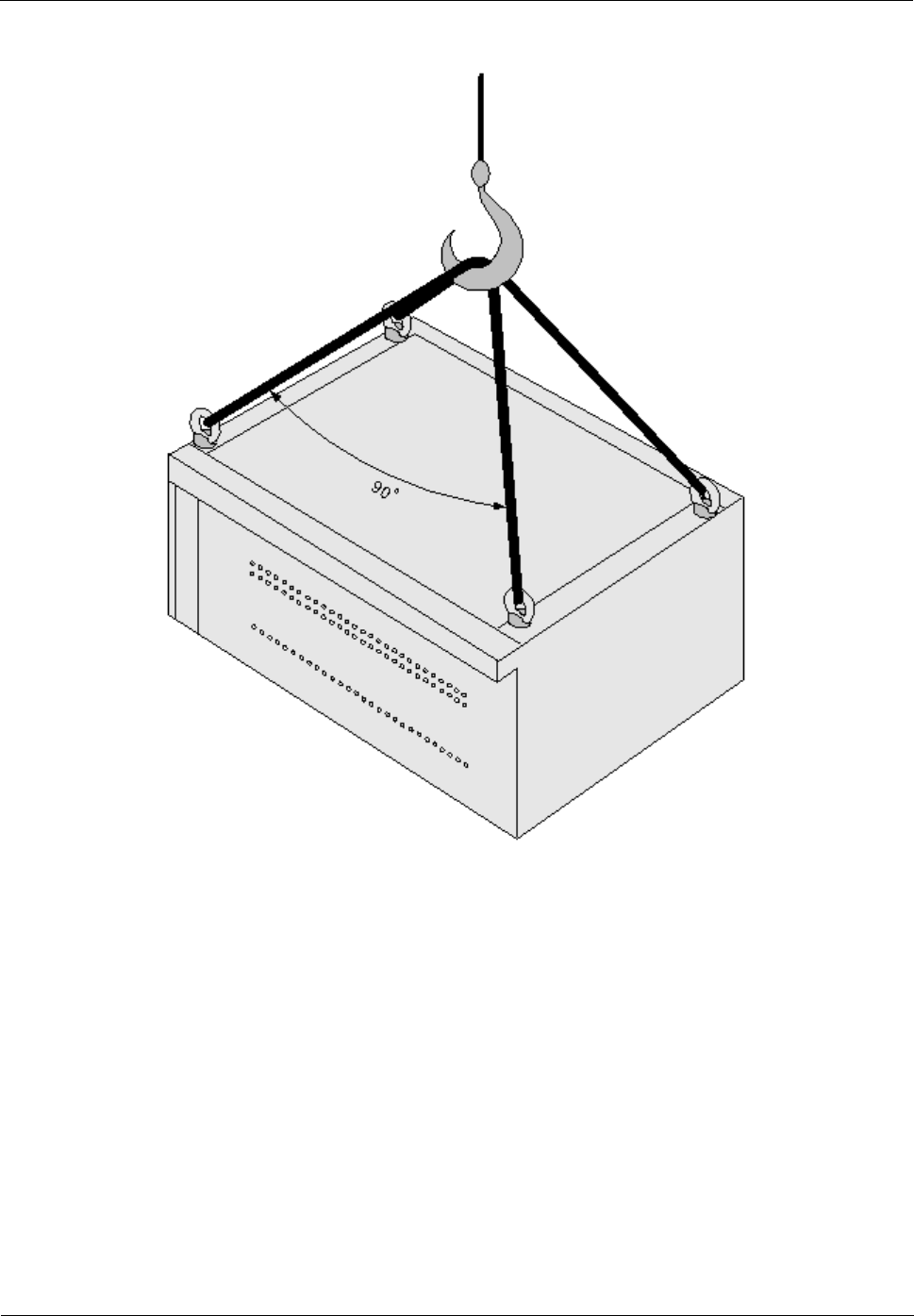
Huawei AR1200&AR2200&AR3200&AR3600 Series
Enterprise Routers
Safety and Regulatory Compliance Information
4 Sicherheitsinformationen
Issue 07 (2015-05-08)
Huawei Proprietary and Confidential
Copyright © Huawei Technologies Co., Ltd.
37
Figure 4-2 Heben von großen Gewichten
Maximal
4.6.2 Sicherheitsleitfaden zur Verwendung von Leitern
Überprüfen der Leiter
Überprüfen Sie vor Verwendung der Leiter zuerst, ob die Leiter in gutem Zustand ist. Stellen
Sie sicher, dass Sie das maximale Gewicht kennen, das die Leiter tragen kann. Ein Überlasten
der Leiter ist strengstens verboten.
Aufstellen der Leiter
Der Neigungswinkel sollte 75 Grad sein. Die Neigung kann mit einem Winkelmesser oder mit
den Armen gemessen werden. Stellen Sie bei Verwendung einer Leiter das breitere Ende der
Leiter auf den Boden. Ergreifen Sie ansonsten Schutzmaßnahmen am unteren Teil der Leiter,
um ein Rutschen zu verhindern. Stellen Sie die Leiter auf einen stabilen Boden.
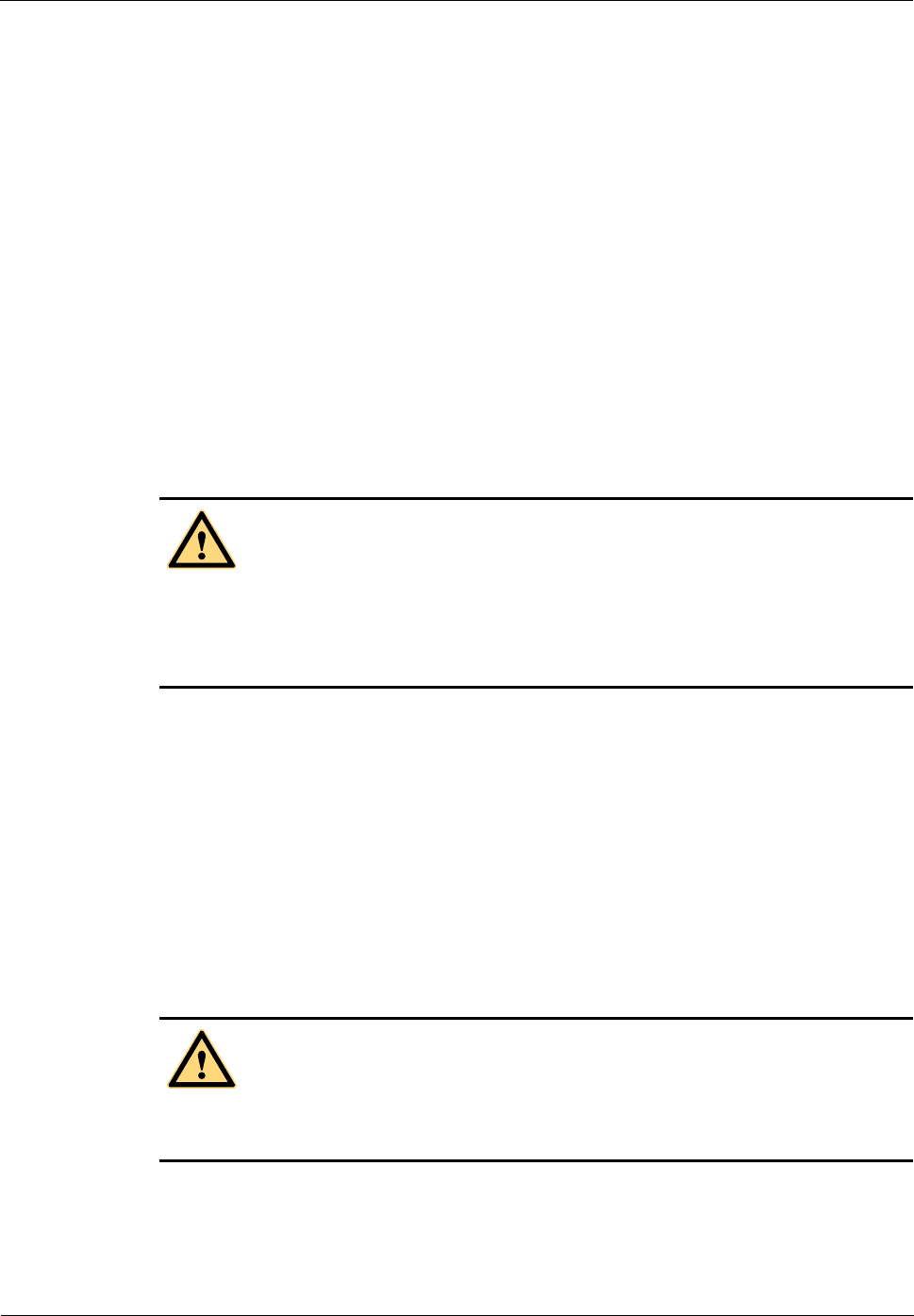
Huawei AR1200&AR2200&AR3200&AR3600 Series
Enterprise Routers
Safety and Regulatory Compliance Information
4 Sicherheitsinformationen
Issue 07 (2015-05-08)
Huawei Proprietary and Confidential
Copyright © Huawei Technologies Co., Ltd.
38
Besteigen der Leiter
Beachten Sie beim Besteigen der Leiter Folgendes.
Stellen Sie sicher, dass der Schwerpunkt Ihres Körper nicht jenseits des Randes der
Leiter liegt.
Um die Gefahr zu verringern und die Sicherheit zu gewährleisten, sollten Sie vor der
Durchführung irgendwelchen Arbeiten sicher auf der Leiter stehen.
Steigen Sie nicht höher als die vierthöchste Stufe der Leiter.
Wenn Sie ganz nach oben klettern, sollte die Länge der Leiter einen Meter höher als die
Traufe sein.
4.7 Mechanische Sicherheit
4.7.1 Bohren
Bohren auf dem Gestell ohne Erlaubnis ist strengstens verboten. Bohren, das die
entsprechenden Anforderungen nicht erfüllt, kann die Drähte und Kabel im Gestell
beschädigen. Wenn Metallspäne aufgrund des Bohrens in das Gestell fallen, kann dies zu
einem Kurzschluss der Leiterplatten führen.
Tragen Sie beim Bohren eines Lochs am Gestell isolierte Handschuhe und entfernen Sie
die Kabel im Gestell.
Stellen Sie während des Bohrens sicher, dass Ihre Augen geschützt sind. Heiße Späne
können Ihre Augen verletzen.
Stellen Sie sicher, dass keine Metallspäne in das Gestell gelangen.
Nicht vorschriftsgemäßes Bohren kann die elektromagnetische Abschirmung des
Gestells beschädigen.
Entfernen Sie die Metallspäne nach dem Bohren umgehend.
4.7.2 Scharfkantige Gegenstände
Tragen Sie, wenn Sie das Gerät von Hand transportieren, Schutzhandschuhe, um Verletzungen
durch scharfkantige Gegenstände zu vermeiden.
4.7.3 Umgang mit Ventilatoren
Stellen Sie Folgendes sicher:
WARNUNG
WARNUNG
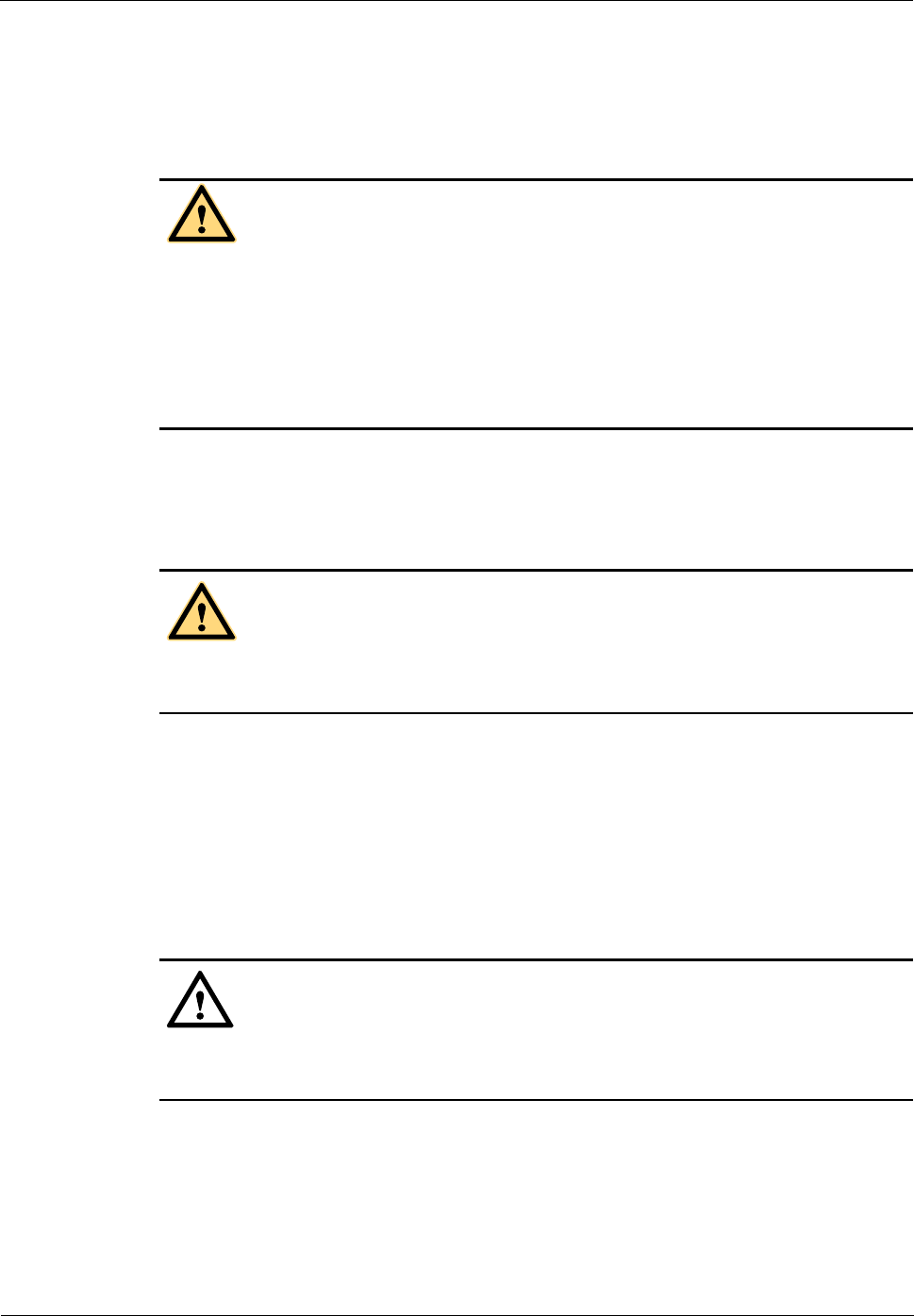
Huawei AR1200&AR2200&AR3200&AR3600 Series
Enterprise Routers
Safety and Regulatory Compliance Information
4 Sicherheitsinformationen
Issue 07 (2015-05-08)
Huawei Proprietary and Confidential
Copyright © Huawei Technologies Co., Ltd.
39
Stellen Sie beim Austauschen eines Bauteils das Bauteil, die Schrauben und das
Werkzeug an einen sicheren Ort, um zu verhindern, dass sie in den laufenden Lüfter
fallen.
Stecken Sie beim Austauschen der Umgebungsvorrichtungen rund um den Lüfter nicht
Ihre Finger oder die Leiterplatte in den laufenden Lüfter. Warten Sie, bis der Lüfter
ausgeschaltet ist und nicht mehr läuft.
Nur Huawei kann das Gerätegehäuse zur Wartung der Gebläse öffnen.
Vor dem Öffnen des Gehäuses muss die Stromversorgung getrennt werden. Vor der
Wiederherstellung der Stromversorgung muss das Gehäuse wieder geschlossen werden.
Die defekte Einheit muss zurück zum Hersteller geschickt werden, damit sie von
fachlich qualifizierten Techniker repariert werden kann.
4.7.4 Heben schwerer Gegenstände
Stehen oder gehen Sie beim Heben schwerer Gegenstände nicht unter dem Arm oder dem
gehobenen Gegenstand.
4.8 Verschiedenes
4.8.1 Einsetzen und Entfernen von Leiterplatten
Beachten Sie beim Einsetzen und Entfernen von Leiterplatten die folgenden Anforderungen:
Behandeln Sie Leiterplatten beim Einsetzen vorsichtig, um ein Verdrehen der Stifte auf der
Rückseite zu verhindern.
Setzen Sie Leiterplatten nur entlang der Führungsschlitze ein.
Die zwei Seiten einer Leiterplatte sollten keine andere Leiterplatte berühren, um
Kurzschlüsse oder Kratzer zu verhindern.
Berühren Sie die Leiterplatte, Bauteile, Anschlüsse oder Anschlussschlitze nicht, wenn
Sie eine Leiterplatte in der Hand halten.
WARNUNG
WARNUNG
VORSICHT
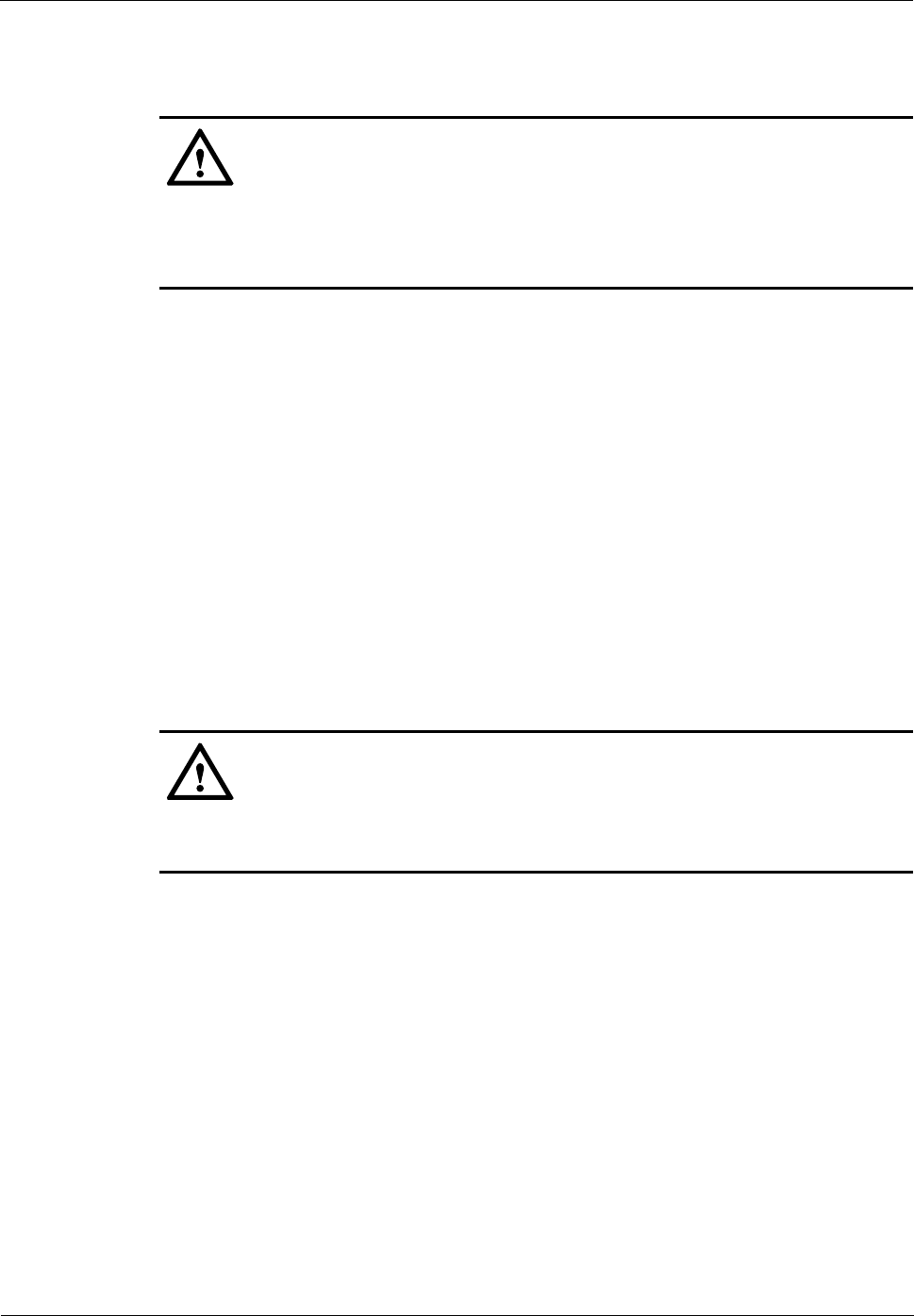
Huawei AR1200&AR2200&AR3200&AR3600 Series
Enterprise Routers
Safety and Regulatory Compliance Information
4 Sicherheitsinformationen
Issue 07 (2015-05-08)
Huawei Proprietary and Confidential
Copyright © Huawei Technologies Co., Ltd.
40
4.8.2 Bündeln von Signalleitungen
Bündeln Sie die Signalleitungen getrennt von Starkstromkabeln oder
Hochspannungskabeln.
Benutzen Sie Kabelbinder in einen Abstand von maximal 150 mm.
4.8.3 Verkabelungsanforderungen
Bei sehr niedrigen Temperaturen kann eine Bewegung der Kabel die Kunststoffhülle der
Kabel beschädigen. Um die Bausicherheit zu gewährleisten, befolgen Sie die nachfolgenden
Anordnungen:
Stellen Sie beim Installieren von Kabeln sicher, dass die Umgebungstemperatur über
0 °C liegt.
Wenn Kabel an Orten unter 0 °C aufbewahrt werden, sollten Sie die Kabel an einen Ort
mit Raumtemperatur transportieren und dort die Kabel vor der Installation mindestens
24 Stunden aufbewahren.
Bewegen Sie die Kabel vorsichtig, besonders bei niedrigen Temperaturen. Lassen Sie die
Kabel nicht direkt vom Fahrzeug fallen.
4.9 3G Antenne
Das Produkt verwendet eine Standard-3G-Antenne. Antennen dürfen nur von
qualifiziertem Personal montiert und gewartet werden.
VORSICHT
VORSICHT